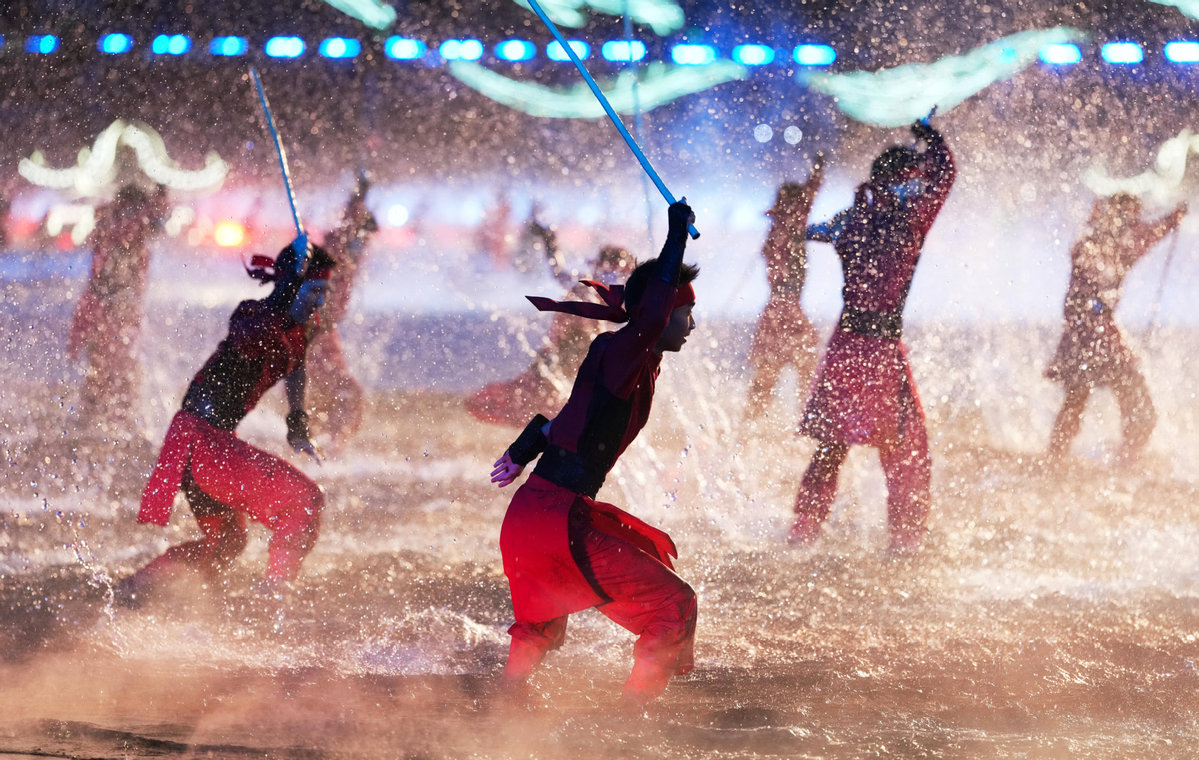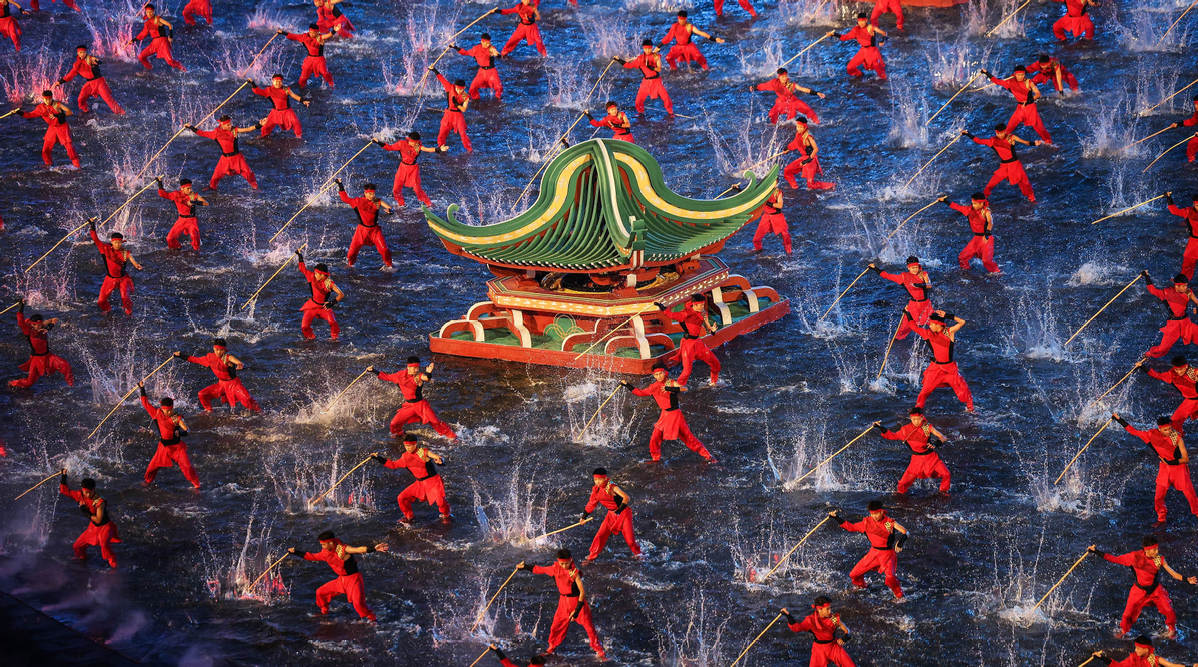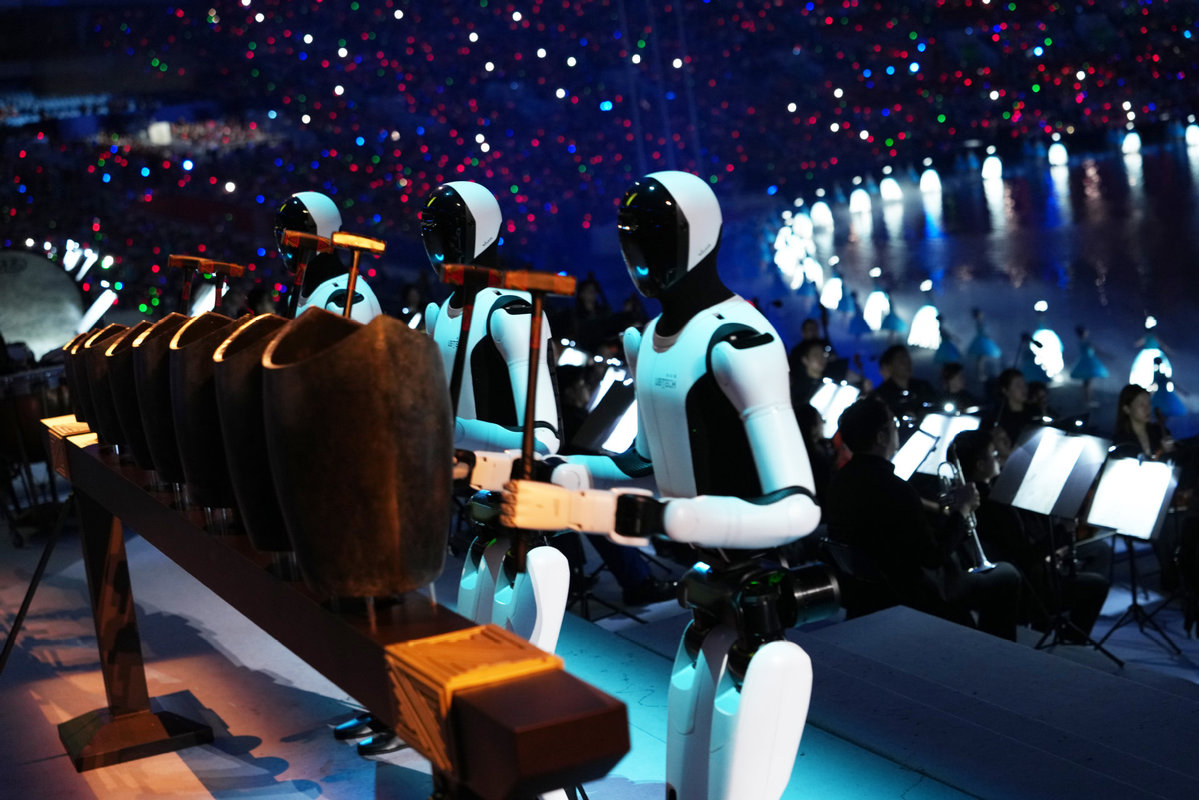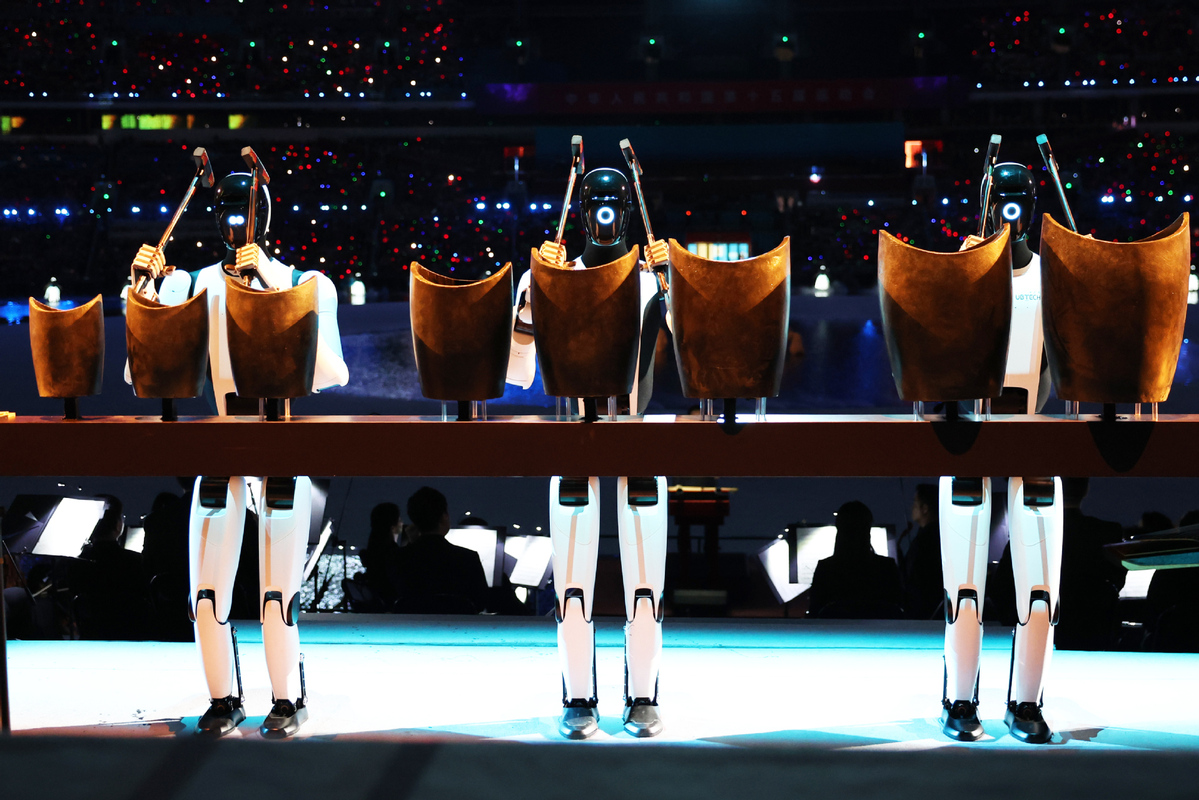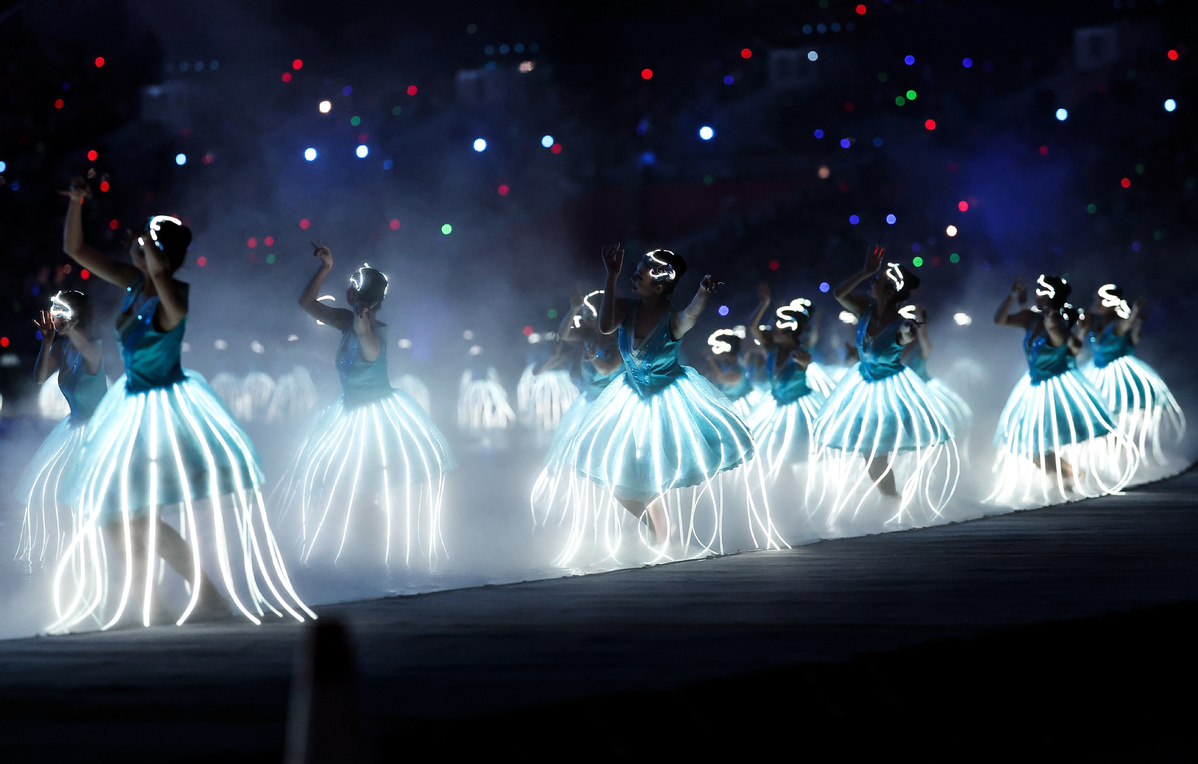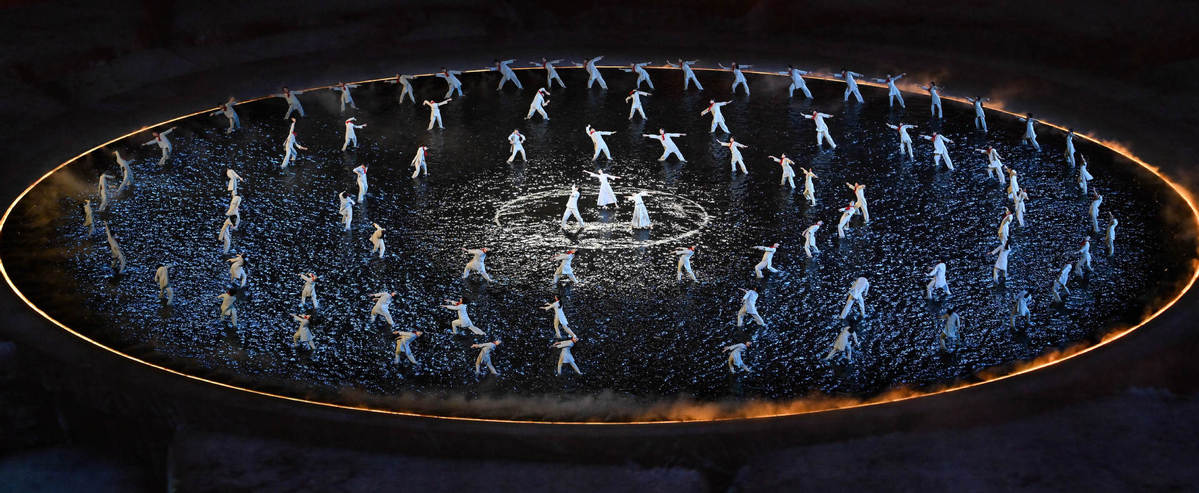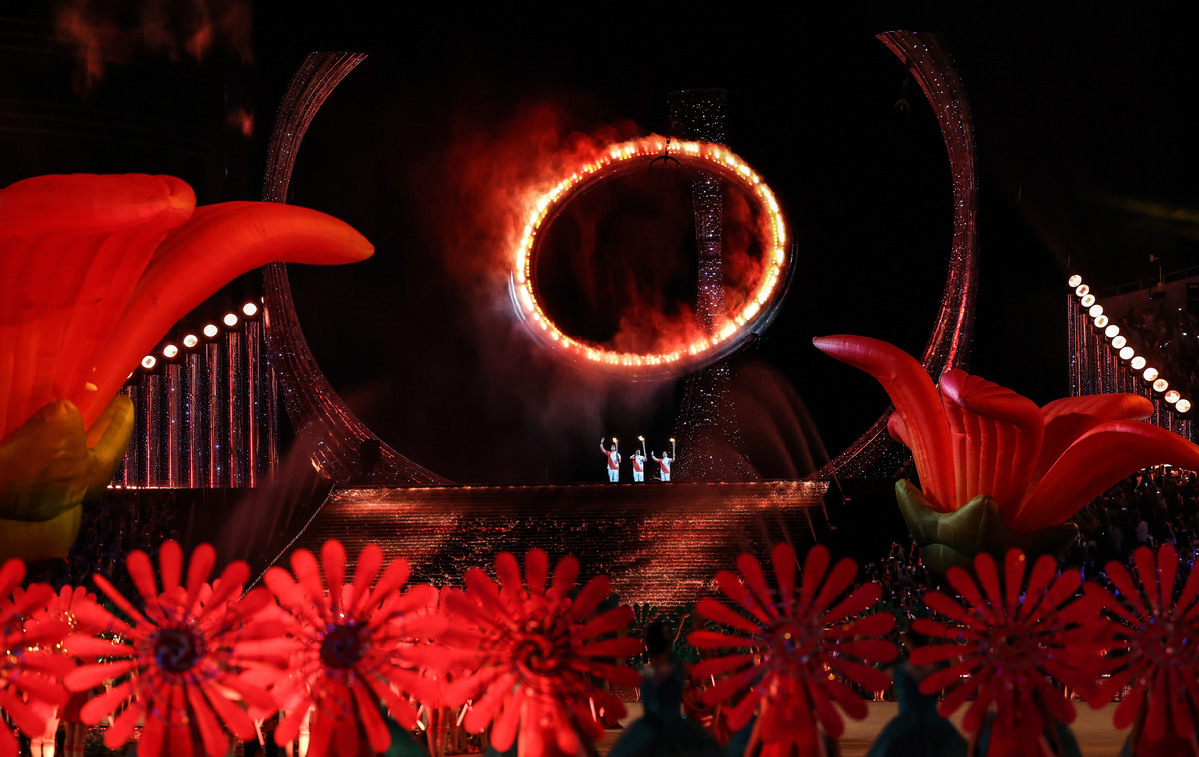

China's 15th National Games will open on Nov 9 across the Guangdong-Hong Kong-Macao Greater Bay Area, marking the first time three regions have co-hosted the country's premier multi-sport event.
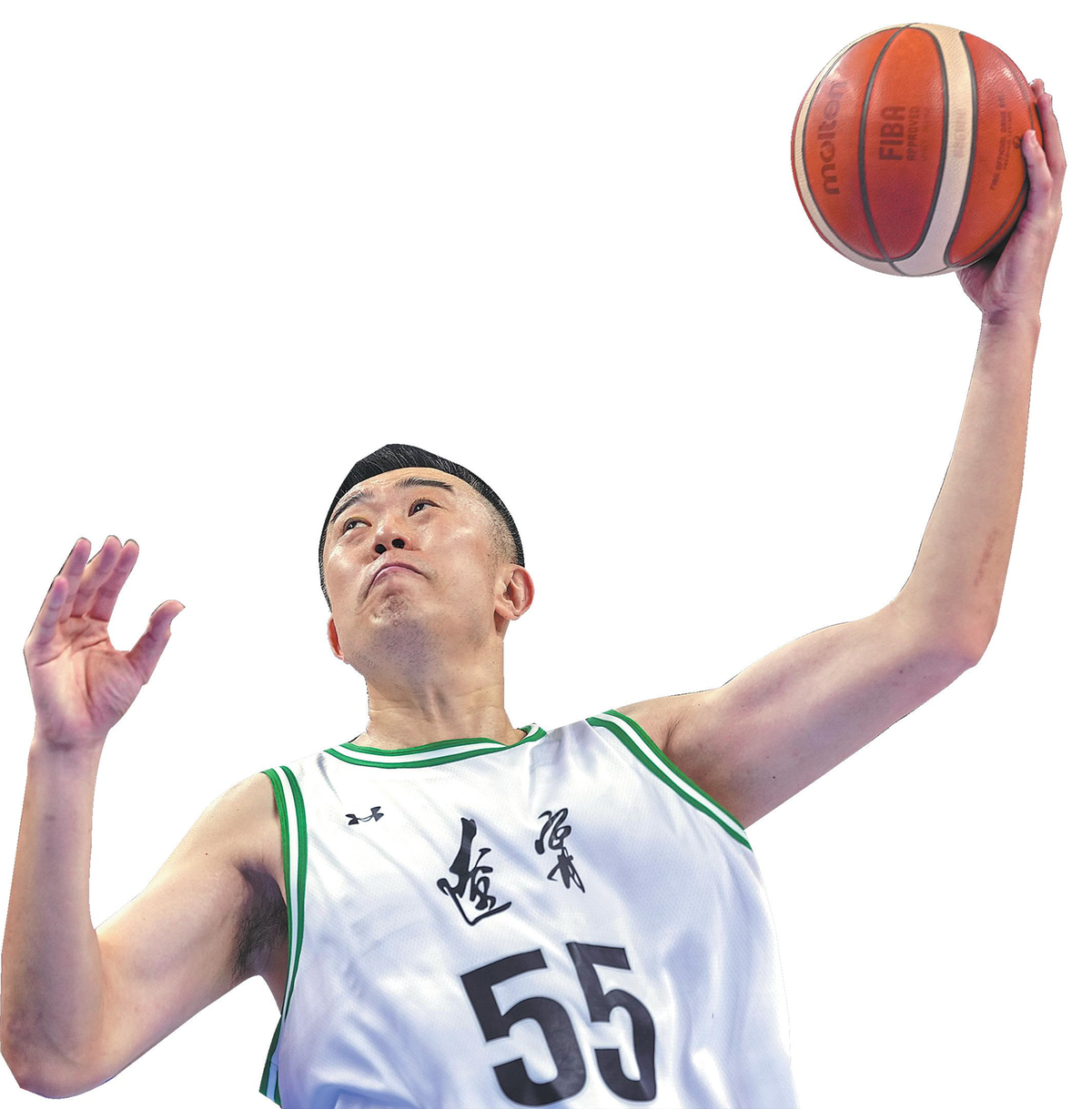
Every time basketball veteran Han Dejun is substituted during a game, he has a ritual: a salute to the crowd in a different direction. On Wednesday, in the men's bronze-medal match of the 15th National Games in Dongguan, Guangdong province, Han gave his final salute.
At 38, Han officially retired after the match, in which Liaoning lost 60-81 to Sichuan and missed out on a podium finish. In the gold-medal game, host Guangdong defeated Zhejiang 101-65, ending a 12-year wait to reclaim its National Games crown. At the previous two editions of the Games, its tilt at gold fell short, and Liaoning took the title both times, beating the Xinjiang team in 2017 and Guangdong in 2021.
This time around, though, the pair met in the semifinals. Guangdong's 92-73 victory over Liaoning has been hailed by fans as the two sides' most significant showdown over the past decade.
From 2013 to now, four National Games titles have been divided between Liaoning and Guangdong. The CBA champion sides, the Liaoning Flying Leopards and Guangdong Southern Tigers, have each won four championships. At its peak, the rivalry was celebrated by fans as the "Spring Festival gala of Basketball".
The epic rivalry has long transcended pure sport, becoming a symbol of Chinese basketball and a witness to the growth of a generation of players.

With Han's retirement, Liaoning faces the challenge of a generational transition, alongside the rise of teams like Zhejiang. The era of Liaoning-Guangdong supremacy is largely over, and the battle for dominance in Chinese men's basketball is entering a new chapter.
"Things have changed," said Guangdong head coach Du Feng after defeating Liaoning in the semifinals.
"The last National Games are still fresh in the memory. Liaoning relied on first-team national players like Zhou Qi, Han, Li Xiaoxu and Guo Ailun to win the championship. We had 'the black-white-short trio' of Zhao Rui, Hu Mingxuan and Xu Jie. All three of them are still playing, now four years older, and have become core members of the national team, receiving the baton from their predecessors," Du said.
"I think this is the essence of basketball inheritance, and also the mission of those devoted to the sport. I hope everyone involved in basketball can dedicate their efforts to the career they love."
Liaoning head coach Yang Ming, who transitioned from player to coach and has witnessed the rivalry on both sides of the paint, reflected on the significance of the matchup.
"The 'Liaoning-Guangdong' debate has been a heated one over the past decade. During this period, both teams produced many brilliant games. They won and lost against each other, needled each other, but cherished and enjoyed their time together," he said.
"Whether we'll see another rivalry at the same level in the future is hard to say, but I hope everyone remembers this wonderful period."

The Liaoning-Guangdong rivalry has mirrored the evolution of Chinese basketball. Beyond a clash of northern and southern styles, it has showcased tactical innovation, talent development and industry growth, becoming a national basketball event that carries both fan passion and regional culture.
Liaoning is known for its size and strength in the paint and defensive intensity, reflecting the resilience of Northeast China. Guangdong excels in fast transitions and smooth passing, highlighting southern teams' speed and strategy. These contrasting styles have clashed repeatedly, influencing each other and pushing the game toward greater balance and diversity.
The showdowns have provided a high-level competitive platform, encouraging the league to invest in youth development. Hu, for example, was named MVP in the 2021 CBA Finals matchup between Guangdong and Liaoning — a vivid illustration of how "big-stage" games can forge new talent.
Off the court, the rivalry has intertwined basketball with regional culture and shaped the memories of a generation of fans. Games between the two teams consistently drew peak viewership and social media attention, boosting the league's commercial value.
Looking ahead, it's likely that Chinese basketball will see new rivalries emerge, tactics evolve and new stars rise. Yet, the Liaoning-Guangdong battles will be remembered as a decadelong testament to dedication, passion and basketball excellence.
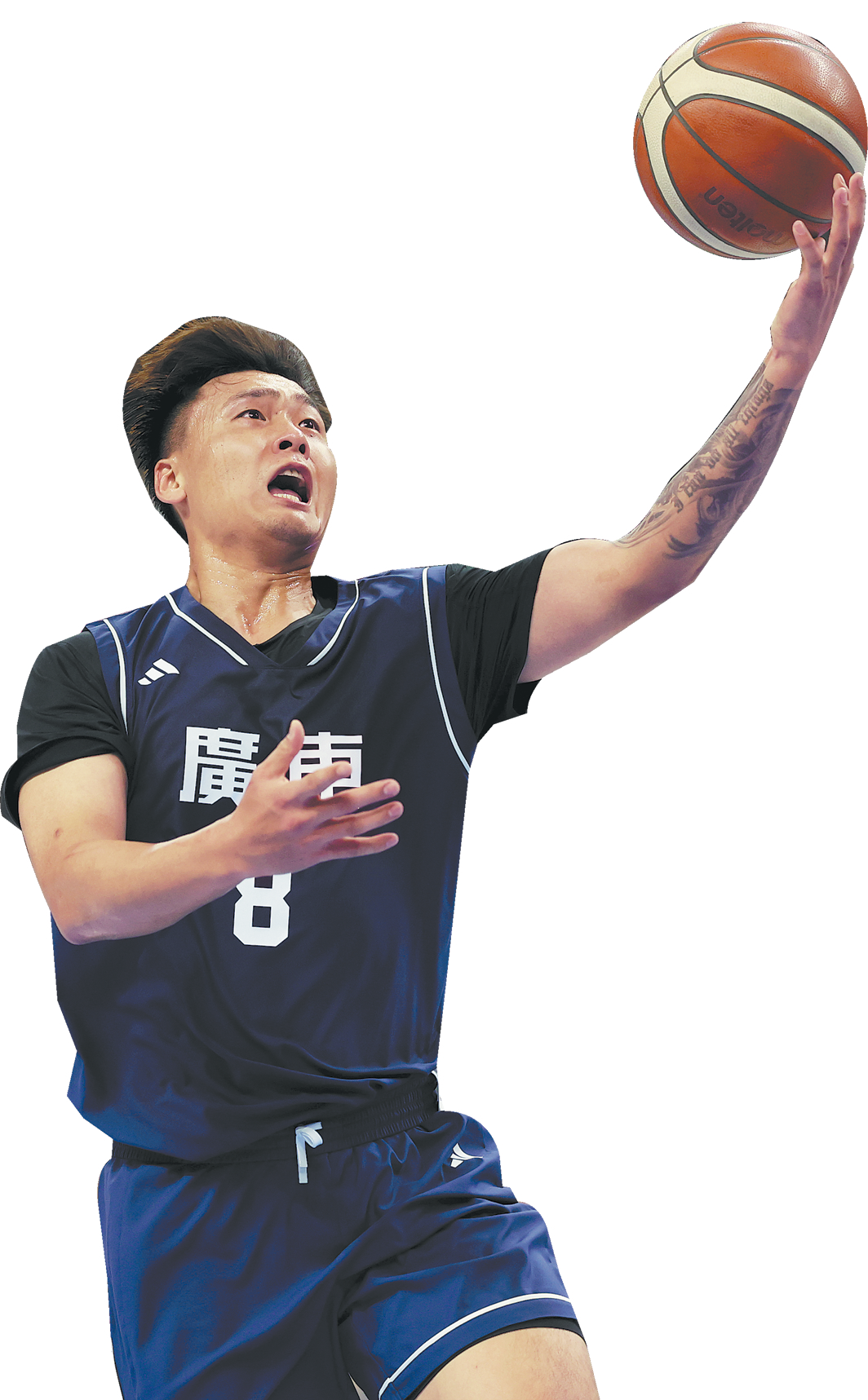
Farewell to a captain
Embodying all of those values, with two National Games titles and four CBA championships to his name, Liaoning captain Han chose the 15th National Games to close the final chapter of his 18-year professional journey — a farewell both personal and emblematic of the end of an era.
As Liaoning's captain, he led his teammates in cleaning the players' locker room after all matches concluded. "I want to stand my last post well," he said, "and leave the Liaoning team for the National Games in the best possible way."
Teammate Gao Shiyan expressed deep admiration: "Playing with him for so many years, he's more than a teammate, he's a brother. Even at 38, he fights so hard on the court, inspiring the entire team — he's our role model."
Zhou Qi, Han's former teammate and an opponent in the bronze-medal match with Sichuan, also sent his best wishes: "I can only wish him well, hoping he enjoys life even more now that there are no more games."
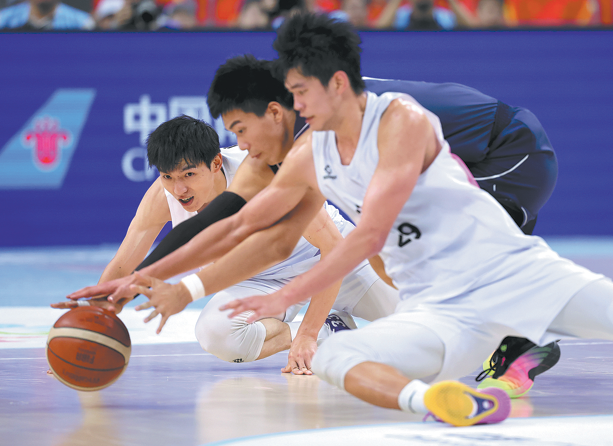
Han's career has been marked by dedication and loyalty. Since joining Liaoning in 2007, he spent 18 years with the team, remaining committed, even when offered record-breaking contracts by other clubs.
"I was born and raised in Liaoning. Contributing to Liaoning is what I should do," Han said.
During the semifinals at Dongguan Basketball Center, the arena was filled with Guangdong fans cheering loudly for the home team. After the match, the MC invited the crowd to salute Liaoning veterans Han and Li Xiaoxu.
"This is their last National Games as players. I think we should give them our applause, celebrate the Liaoning-Guangdong rivalry we've cherished, and honor our basketball youth," he said.
"To youth; never regret!"
Hong Kong pedal ace Ceci Lee Sze-wing's successful title defense in the women's road cycling individual event during the ongoing 15th National Games has once again turned the spotlight on the city's cycling team, which is known for its stellar show in premier tournaments.
Lee's gold is the second for the Hong Kong Special Administrative Region so far in this year's games, and she is also the third athlete from the SAR to triumph more than once at the National Games after Asian cycling legend Wong Kam-po and Olympian Sarah Lee Wai-sze.
While hard work and discipline form the mainstay of Hong Kong cycling team's medal-winning performances, the application of cutting-edge sports technologies developed through the joint efforts of the Chinese mainland and Hong Kong has been a significant contributor to its success.
A central research facility at Hong Kong University of Science and Technology, which specializes in developing high-tech aerodynamic and acoustic surroundings, boasts a low-noise wind tunnel that can simulate a cycling race environment.
This facility, when further empowered by the nation's Tianhe 2 supercomputer in Guangzhou, Guangdong province, can not only improve cyclists' riding postures, but also assist in the development of the most suitable bike design and cycling bodysuit for them.
Zhang Xin, director of the university's Aerodynamics and Acoustics Facility, highlighted the importance of using a supercomputer to develop sports technologies. As human muscle tissues and physical conditions constantly change, the computation process is complex and requires the use of a supercomputer, he said.
Athletes of the Hong Kong cycling team have worn aero-speed suits developed and tested in the wind tunnel to compete at various major sports events, including the Tokyo 2020 Olympic Games and the 2022 Asian Games in Hangzhou, Zhejiang province. These bodysuits, tailor-made for each athlete, are estimated to reduce wind drag by an impressive 3 percent.
Other sports disciplines, such as windsurfing and triathlon, have also employed simulations developed using the supercomputer and the wind tunnel to optimize the postures and movements of athletes.
During training sessions in Stanley on Hong Kong Island, sensors developed by the university recorded athletes' physical data, which was subsequently analyzed using the supercomputer.
According to Zhang, the Tianhe 2 simulated the wind conditions at the Paris 2024 Olympic Games and provided the information to head coaches of the windsurfing and sailing teams. The supercomputer helped to enhance athletes' posture optimization, as well as design and select equipment, he said.
Sports technology cooperation between the mainland and Hong Kong has deepened in recent years, with more agreements signed for further development, serving both professional athletes and the public.
In September, Hong Kong Polytechnic University and mainland sportswear brand Li-Ning signed a memorandum of understanding to establish the Li-Ning-PolyU Joint Research Centre for Sports Science, which aims to enhance technological application and promote industrial transformation in the sports and health sectors.
In Guangzhou, the Nansha Sub-Center of National Supercomputer Center provides the mainland's first supercomputer direct network line for Hong Kong. A dedicated high-speed fiber-optic network from the Tianhe 2 supercomputer is used to link Guangdong and Hong Kong's scientific innovation capabilities, enabling Hong Kong users to swiftly utilize the nation's supercomputing resources. The center has continuously provided support for technological innovation in Hong Kong and Macao.
For athletes from Macao and Hong Kong, traveling to the mainland for training and using sports technologies to improve their skills have become common.
Macao athlete Chan Man-hin, who participated in the National Games sailing event last month, said he was equipped with a high-end GPS tracker when he trained on the mainland. The device collected his performance data, including instantaneous speed and direction during sailing, for further analysis to help improve performance, he said.
"The piece of equipment allowed me to analyze all the training data and adjust my strategy for the day of the competition," Chan said.
The nation's support for sports development in its special administrative regions extends beyond hardware to include talent cultivation.
At Guangzhou Zhongshan Whampoa School for Hong Kong and Macao Students, a base has been established to provide a professional training platform for students from Hong Kong. Selected student athletes receive targeted training in five disciplines — fencing, swimming, equestrian, shooting and running.
These athletes also get more opportunities to participate directly in competitions at provincial, national and even international levels. By undergoing scientific and systematic training, they can gain recognition of the Sports Federation and Olympic Committee of Hong Kong, China, and have the chance to register as Hong Kong athletes, potentially becoming the city's elite sports representatives.
atlasshao@chinadailyhk.com

China's diving "Dream Team" will likely remain the dominant medal collector at the 2028 Los Angeles Olympics, backed by its deep talent pool and the divers' world-class performances at the National Games.
With a legion of multiple-time Olympic and world champions clashing at one meet, the diving program in Guangzhou, has, perhaps, outranked all other international events in terms of the quality of the field, making it, arguably, the toughest competition in the careers of China's best divers.
Athletes representing their respective home provinces, or municipalities, had to beat more world-champion-caliber opponents at the 15th National Games than they ever normally face at international events, to reign supreme in each of the 14 individual and team disciplines.
After winning the women's 10m platform gold on Monday, four-time individual world champion Chen Yuxi said she's even more pleased to see the collective rise of the younger generation than claiming her maiden National Games individual title.
"For competitive sports, having a steady stream of talent is more important than being strong alone in promoting the event's development," said Chen, representing Team Shanghai at the Games, which are being held in Guangdong province and the special administrative regions of Hong Kong and Macao.
Chen also won a gold medal in the synchronized 10m platform alongside diving partner Zhang Minjie last week.
According to official statistics from the 15th National Games, eight of the 12 athletes who competed in women's individual 10m platform were born after 2010, with the youngest, Liu Zihan, just 11 years old, demonstrating China's deep talent pool in the sport.
"To be able to compete with so many experienced and decorated older sisters, and finish on the podium together with them, I am just happy," Liu, who won bronze in 10m platform, said while looking up at Chen during the post-final news conference.

For the 20-year-old Chen, her own regret of having not claimed an individual Olympic gold yet, and only winning at the National Games this year, largely came down to the dominance of her national teammate, the seemingly invincible Quan Hongchan, who had been sidelined for almost half a year by multiple injuries, before making an impressive return in Guangzhou.
The 18-year-old diving prodigy drew loud cheers from a capacity crowd at the Guangdong Olympic Sports Center's swimming and diving hall on Nov 2, when she helped the Guangdong squad win the women's team discipline at the Games in her first official competition since May.
The teen master of the "splash-disappearing technique", referring to her deft body control that keeps the splash to a minimum when she enters the water, delivered once again, suggesting that she's not done yet, even having won back-to-back individual 10m platform Olympic titles by beating Chen both times at Tokyo 2020 and Paris 2024.
"I still believe I am competing well enough that I could complete a full set of dives with quality," Quan said after finishing fifth with Wang Weiying in the synchro discipline on Nov 5.
"I am not at my best now, but I am happy, and really enjoying the competition."
Chen, Quan's gold-winning synchro partner in Paris, welcomed the return of her friend and biggest individual rival, saying she expects Quan to return to her peak form soon, as their healthy competition always helps bring out the best in each other.
Women's reigning Olympic 3m springboard champion Chen Yiwen, 26, had to settle with a bronze in the individual final on Tuesday, beaten by her fellow Guangdong teammate and eventual gold winner Lin Shan and runner-up Chen Jia, representing Sichuan province.
"All the other divers have done pretty well, better than I did, in this final, showing how high the level of competition has been," said Chen Yiwen.
In men's events, Wang Zongyuan's surging form, underlined by his individual 3m springboard win on Monday, suggested that he will keep pushing Team China's drive to dominate the springboard together with two-time individual Olympic champion Xie Siyi, who won the synchro with Guangdong teammate Huang Bowen.
The duel between Shandong's Lian Junjie and Beijing veteran Cao Yuan on the 10m platform, where Lian won his national title by beating Cao on Tuesday, is expected to continue sharpening the pair's skills in the buildup to LA28.
"I am still a climber, in terms of achieving my career goal at the LA Olympics," said the 25-year-old Lian, who won his sole Olympic gold in men's synchro 10m platform with Yang Hao in Paris.
"China's diving team builds on its tradition that each generation passes on to the next, in order to always stay competitive and on top of the world.
"For the younger guys, I just hope they stay resilient and mentally strong to withstand the grind of hard training every day. Perseverance is the key to success."
China's world-beating diving squad swept all eight gold medals at Paris 2024, after collecting seven out of eight at Tokyo 2020.
Zhou Jihong, who came out of retirement to return as head coach of the national team in June, has sent a strong signal that the program will go all out on its journey to LA28, with its sights firmly set on another golden sweep.
Notably, it was Zhou who won the country's first-ever Olympic diving gold at Los Angeles 1984.
Contact the writers at zhengcaixiong@chinadaily.com.cn
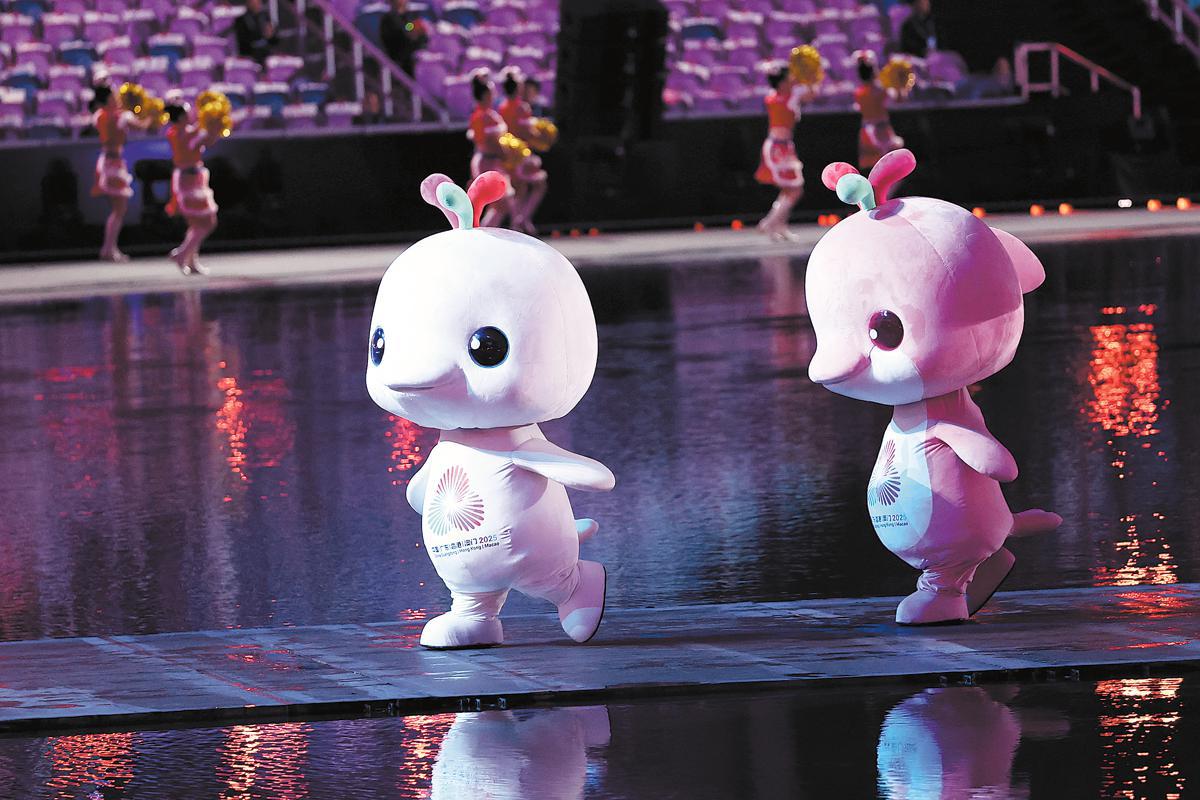
Through their headspins, high jumps and playful antics, the mascots Xi Yangyang and Le Rongrong, inspired by the Chinese white dolphin, have become the unexpected stars of the ongoing 15th National Games, stealing the show at venues across the three host regions.
Their design was led by Liu Pingyun, the mind behind the beloved Beijing Winter Olympics panda mascot, Bing Dwen Dwen. Liu explained the evolution: "Bing Dwen Dwen's barrel-shaped body, with no defined waist, limited its range of motion. This time, we gave Xi Yangyang and Le Rongrong a two-heads-tall proportion, which allows for much smoother and more dynamic movement." He noted that the new duo represents a clear step up in athletic expressiveness.
This design refinement not only makes the mascots more versatile in graphic depictions of various sports, but also grants the live performers inside the costumes far greater flexibility.
This enhanced mobility is on full display at venues like the Dongguan Basketball Center where, during timeouts, the mascots erupt with energy the moment the hip-hop music drops. They trade break dancing moves, rapid tail spins and even headstands, driving the crowd into a frenzy of cheers.
Videos of their antics have gone viral on social media, with many online declaring them the most energetic mascots they have ever seen. Photos of the mascots have been turned into memes in both Mandarin and Cantonese, sparking widespread speculation about who brings the characters to life with such infectious energy.
The answer, in part, lies in a group of 23 performers from the Foshan Huangfeihong International Martial Arts School, who were selected to bring the mascots to life during the opening ceremony.
"A solid martial arts foundation helps them adapt to the physical demands of mascot performance," explained Zhang Yingyan, the school's vice-principal. She added that the selection process emphasized not only martial arts skills, but also discipline and teamwork.
To prepare, the team began training as early as late July, practicing spins, jumps and arm movements to ensure their portrayal of the dolphins felt natural and lively.
When asked about the mascots' sudden internet fame, Zhang seemed pleasantly surprised. "We were completely caught off guard by it," she admitted. "We never expected them to become this popular."
The mascots' biological inspiration carries profound symbolic meaning. The Chinese white dolphin is a resident of the Pearl River Estuary, known as the "giant panda of the sea" and classified as a grade 1 national key protected species.
Adult Chinese white dolphins are typically white when calm, but turn pink when active due to increased blood flow — inspiring the dual color scheme of the cuddly duo.
Liu explained that the dolphin symbolizes the maritime culture of the host region — the Guangdong-Hong Kong-Macao Greater Bay Area.
"Chinese white dolphins are social animals that live and move together, reflecting the spirit of unity, perseverance and endeavor seen in athletes," he said.
He further emphasized the cultural resonance that the dolphins' annual return to the Pearl River Estuary symbolizes a profound connection to their homeland, reflecting the deep-rooted bonds among the people of Guangdong province and the special administrative regions of Hong Kong and Macao.
This symbolism proves particularly relevant given the Games historic joint hosting, representing a new era of regional cooperation.
"In choosing a representative for the Games, we deliberately selected a creature less familiar in daily life," Liu explained.
He noted that the Chinese white dolphin, residing in the ocean beyond our usual reach, perfectly symbolizes the innovative thinking and future-oriented vision of the Greater Bay Area.
"Our challenge was to transform this unfamiliar marine creature into approachable, engaging characters through design."
The mascots' final design depicts dolphins with rounded bodies, human-like limbs, and distinctive blue, green and yellow adornments atop their heads representing water spraying from their blowholes.
Yet, their appearance has sparked a wave of online humor, with many people affectionately dubbing them the "great bay chickens" — also a lighthearted nod to the chicken's revered role in Cantonese cuisine and culture. The nickname has since taken hold locally, further fueled by the Cantonese pronunciation of "chicken," which sounds similar to the word for "good fortune" and carries positive symbolism.
The mascots have inspired extensive creativity, appearing in fan-made videos, memes and cultural products.
Liu embraced the reinterpretation with openness and good humor.
"This kind of grassroots rebranding makes the mascots more approachable," he said.
"By tapping into the local affection for chickens, it draws people in and helps them connect more deeply with the cultural and athletic spirit the mascots represent. I appreciate that," Liu said.
xingwen@chinadaily.com.cn
Move beyond the roar of the crowd for a moment and the most powerful sound at the 15th National Games might be the friendly banter on a shuttle bus or the shared anecdotes over a meal.
As the first-ever National Games co-hosted by Guangdong province and the Hong Kong and Macao special administrative regions captivate the nation, the most enduring victories are perhaps being forged not on the podium, but through personal connections — deeper bonds that are bringing Hong Kong and Macao closer to the Chinese mainland.
A tapestry of unity is being woven, thread by thread, as young athletes cross boundaries to compete, and volunteers welcome them with the full-hearted support of a hometown crowd.
Rico Cheung Siu-hang, 23, a 110-meter hurdler from Hong Kong, who is poised to make his National Games debut this year, said he is eager to engage with his peers from other provincial delegations for the exchange of technical expertise as much as for the shared sense of camaraderie.
When athletes from across the country gather for sports events, they not only share "trade secrets", but also stories about their hometowns, about the local delicacies and hidden travel gems, Cheung said, noting that such anecdotal exchanges happen mostly over meals.
"It's in these moments that our visceral links form," he said, adding that these organic, off-track interactions over the years have profoundly enriched his perspective of different parts of China, fostered a more nuanced understanding of the whole nation and strengthened his sense of national identity.
In preparation for the National Games, Cheung honed his skills in Shanghai this August under the guidance of Sun Haiping, who also coached China's hurdles race star and Olympic champion Liu Xiang.
Cheung arrived in Guangzhou, the provincial capital of Guangdong, with the rest of the Hong Kong athletics team on Wednesday, days ahead of his competition, which is scheduled at the Guangdong Olympic Sports Center on Nov 19.
The hurdler said he is particularly ecstatic about the "precious time window" he is getting, which is a departure from his usually tightly managed competition itineraries, and plans to use it for a leisurely visit to the city's landmark Canton Tower. The 600-meter-tall multipurpose tower is nicknamed "Slim Waist" for its unique twisted design.
Big motivation
Hong Kong para-table tennis player Wong Yue-ching, who will compete in the 12th National Games for Persons with Disabilities in Guangzhou in December, said the anticipation of playing a match before a cheering home crowd offers special motivation.
"Competing on our doorstep means that friends and family members who've never seen me perform live can finally be in the stands," she said. "Having my biggest supporters witness the payoff of years of training would be a massive confidence boost for me."
Wong said she has noticed a groundswell of enthusiasm surrounding sports in Hong Kong in recent days, thanks to the city's role as a National Games co-host.
Promotional campaigns for the games have covered the city — from mass transit railway advertisements to prime-time television slots — and many of her peers are actively signing up as volunteers, she said.
"You can feel the buzz everywhere.... The games have clearly become more than just a sporting spectacle; it is like a citywide mobilization program, galvanizing substantial mass participation and drawing more passion for sports," she added.
Regional integration
The sentiment was echoed by those who have transitioned from competitor to contributor.
Former Hong Kong basketball player Leung Kwok-shing, who has been appointed as one of the SAR's volunteer ambassadors for the games, said he is experiencing the other side of the big-ticket games with a profound sense of duty and national pride.
The volunteer drive in the two special administrative regions has garnered enthusiastic public response, resulting in nearly 20,000 appointments — 16,000 in Hong Kong and 3,500 in Macao — according to the games' volunteer service department in the two cities.
Leung's motivation stems from his stint as a basketball player, during which he suffered injuries and received the care of volunteers. "I hope to switch roles and serve as a volunteer this time to contribute and give back," he said.
At a volunteer mobilization rally in Guangdong in October, Leung witnessed a powerful symbol of regional integration within the Guangdong-Hong Kong-Macao Greater Bay Area. A Hong Kong student currently pursuing studies at a Shenzhen university signed up as a volunteer for the Guangdong competition region.
"This kind of exchange, where we unite as volunteers, truly fosters the integration of the Greater Bay Area," he said. "We are merging our services and our cultures, which is incredibly meaningful."
Leung also voiced his feeling of deep encouragement after seeing a great number of young people supporting the games and national development.
"I can feel the younger generation's eagerness to contribute to society and the country," he said. "This initiative is vital. I hope it spreads, helping to accelerate the growth of their national identity and sense of belonging."
Shared future
On the front lines of this integration are volunteers like Lai Meileng, a 32-year-old primary school teacher in Macao. For her, volunteering for the games is more than just a call of duty; it is a chance to be a welcoming host and a tiny "spark" in a blazing fire of community spirit, as well as a profound opportunity to connect more deeply with the nation.
As a member of the event's transportation coordination team, Lai's role involves shuttling athletes to competition venues, becoming a mobile platform for cultural and personal exchanges. "We aren't just ensuring transportation; we are building bridges," she said.
Lai recalled her recent interaction with mainland athletes on a shuttle bus. "I introduced them to Macao, and they shared their hopes and dreams for the games with me. Even though we are from different places, the distance didn't matter. We felt like friends," she said.
Such interactions form the very fabric of a stronger national identity, which allows Macao residents to understand their mainland compatriots better, Lai said.
Her perspective is also uniquely shaped by her dual role as an educator and a volunteer. She sees this experience as a vital tool for fostering national sentiment in the next generation.
"I can tell my students that the distance between us and the nation's affairs, or even famous athletes, isn't as far as they might think. It can plant a seed in their hearts, showing them that our future is a shared, hopeful one," Lai said.
While physical infrastructure, like the Hong Kong-Zhuhai-Macao Bridge, has long facilitated travel between Macao and the mainland, Lai said she believes that events such as the National Games have the power to build a more robust connection — a human one.
"Previously, I might have thought national development was a distant matter. Now I see that I am intimately connected with the nation's development," she said.
"By fulfilling my own role well, I am contributing to the nation. When everyone plays their part well, the whole society improves," she added.
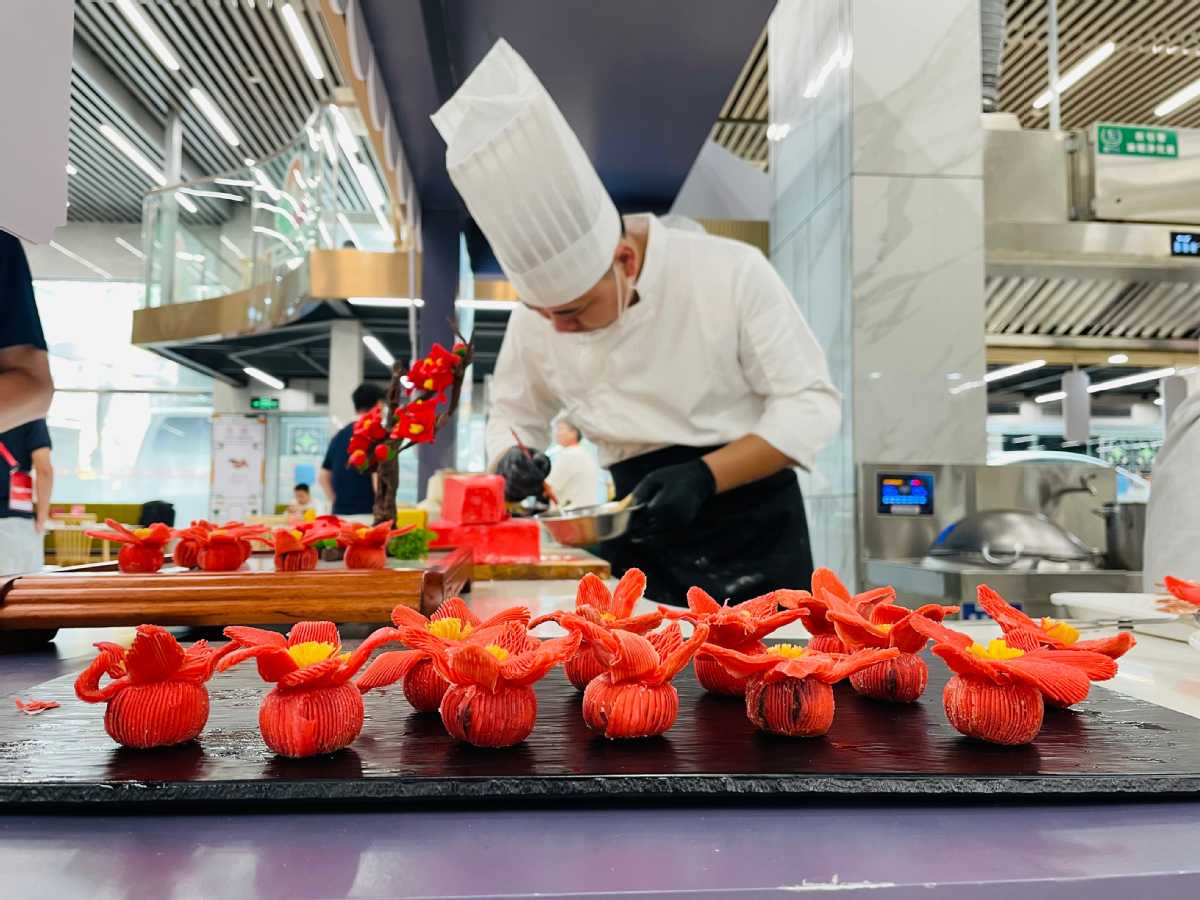
For athletes, the ongoing 15th National Games is a massive domestic sports platform to compete for gold medals. For thousands of spectators, the event is also an opportunity to taste cuisine from Guangdong province, Hong Kong, and Macao.
At the Games' main press center in Guangzhou, the capital of Guangdong, organizers have prepared styled dishes from cities across the province, such as shrimp dumplings, rice noodle rolls, braised goose, and beef balls.
Starting from Nov 9, 21 cities in Guangdong began taking turns hosting food-themed days at the main press center's restaurant, featuring 168 Guangdong-based specialty dishes.
During Wednesday's Shantou theme, braised goose, beef balls, and rice noodles were present, leaving domestic and international journalists covering the games impressed by the city's myriad ways of preparing rice noodles.
The games, jointly hosted for the first time in Guangdong, Hong Kong, and Macao, have attracted over 3,200 registered journalists from domestic and international media outlets.
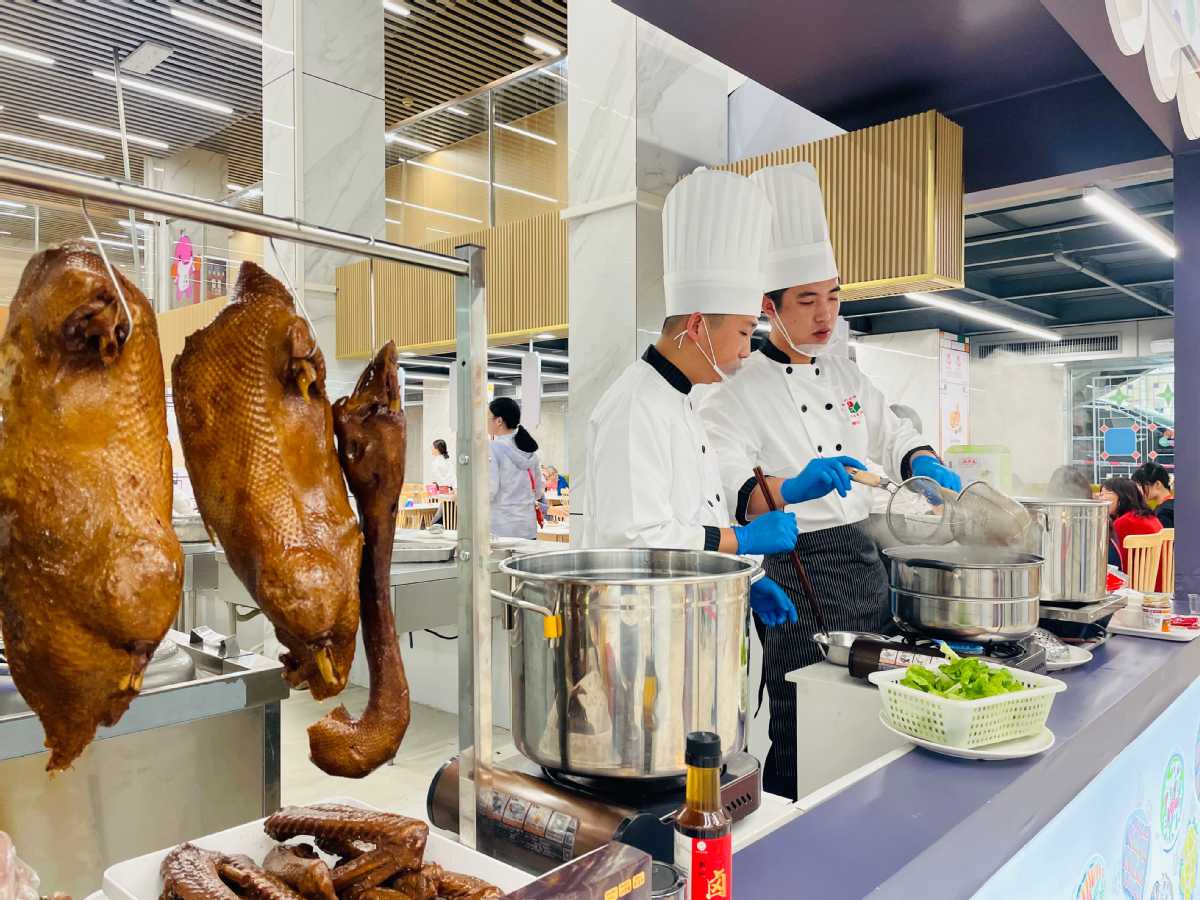

Composed, calm and radiating quiet confidence, Olympic champion Sun Yang faced reporters on Monday night after finishing sixth in the men's 400-meter freestyle final at the 15th National Games in Shenzhen, Guangdong province.
At 34, the three-time Olympic champion no longer shows the emotional tears that used to surface during interviews in his younger days. For him now, swimming is less about the pressure to win and more about the perseverance born of a pure love for the sport.
"Every race is the best test of my current form," he said. "There's no regret. Once a race is over, tomorrow is a new beginning."
The spotlight that evening belonged to 18-year-old Zhang Zhanshuo of Shandong, who stormed to victory in 3 minutes and 42.82 seconds, shattering his own world junior record.
Sun congratulated him poolside, offering words of encouragement. "Zhang is an excellent athlete with a long road ahead," Sun said. "I hope he can carry the future of Chinese men's mid- and long-distance freestyle."
"No matter whether it's young athletes or our older generation, I believe we can all move forward and go further. The era when everyone only focused on results is gradually fading. More often now, whether it's me or the younger athletes, what we display is the true spirit of competitive sports," he said.
Indeed, the cheers that greeted Sun's return to the National Games filled the arena. He said he has no plans to retire and hopes the competition will help him readjust his training — refining his methods to better suit his age.
"My persistence represents the final line of defense for my generation of athletes," he said. "I hope everyone will continue to look forward to a better, more complete version of Sun Yang in the pool."

Sun's journey back to the pool has been anything but easy. After serving a 51-month suspension, he returned to competition last summer, drawing enormous attention from fans and media alike.
At the National Games venue, spectators packed the stands from the preliminary heats to the finals, cheering his every stroke. On Sina Weibo, where he commands over 30 million followers, his post upon arriving in Shenzhen quickly garnered nearly 30,000 likes.
Although he didn't reach the podium in the 400m final, his name still appears beside the Asian and national records — a quiet yet powerful reminder of the glory he once brought to the pool.
Yet Sun must now accept that, with age, his performance is no longer at its peak. In the heats, he ranked eighth — only 0.1 seconds ahead of ninth place — barely qualifying for the final, where he swam in lane eight instead of his once-customary center lanes. All seven of his rivals were born after 2000.
In a previous interview with Sina, Sun admitted he had anticipated this. He returned to competition to assuage his passion, not a thirst for titles — doing so knowing full well that there would come a day when he could no longer be a champion.
"Even if one day I no longer hold Olympic or world records, I still have Asian and national records," he added with a small smile. "I've already achieved what most athletes can only dream of. I'm lucky — one of the fortunate few."
Despite his age, Sun continues to train with the intensity of athletes two decades his junior. Weighted sessions, ten sets of 800m swims — the workload remains immense. "At 34, the biggest difference is that places that never used to hurt now start to ache," he said. "To keep up, I have to work ten thousand times harder."
Cai Li, coach of the Zhejiang provincial swimming team, praised Sun's perseverance. "At his age, maintaining this level of training and competition is extraordinary," Cai said. "Very few athletes worldwide can do what he's doing."
Sun's focus now extends beyond personal victory. "When I was young, I wanted to win China's first men's swimming gold medal," he reflected. "Now, I want to break another barrier — to see how far an older athlete can go."
He hopes to adjust his training methods to better suit his physical condition, emphasizing longevity and adaptability over pure speed.
For Sun, retirement is not yet on the horizon. He knows his best days may be behind him, but his passion endures. "To achieve something great, you must go through storms and waves," he said. "That's what makes an athlete truly remarkable."
And when the time does come to step away, he knows exactly how he wants it to happen. "Whatever I do, I must see it through," he said firmly. "I want to end my career in the pool — even if I lose, even if I fall, it will be in the water."
SHENZHEN -- 13-year-old Yu Zidi of North China's Hebei province won the women's 200m individual medley at the country's 15th National Games on Tuesday, clocking a new Asian record time of two minutes 7.41 seconds.
In May, Yu secured a berth for the World Championships at Shenzhen after finishing second in the event at the National Swimming Championships in 2:10.63, the fastest time ever by a 12-year-old in the discipline.
At the World Championships in Singapore in July, Yu further improved her personal best to 2:09.21 in the final.
The previous Asian record of 2:07.57 was set by Ye Shiwen at the 2012 London Olympics.
The 15th National Games is bringing together many young volunteers who are devoting their passion and energy to this grand national event. Among them are Yao Zhengnuo from Hong Kong and Chu Cheng-wei from Taiwan, who provided support for the spectacular opening ceremony. What was it like to witness such a moment of pride? Follow us to discover their inspiring stories.

The 15th National Games, jointly hosted by Guangdong province and the Hong Kong and Macao special administrative regions from Sunday through Nov 21, mark the first time in Chinese sports history that three regions co-host a major national event.
This will not only deepen sports exchanges and cooperation between the regions but also foster emotional bonds among the three places' people, showcasing united strength in the Guangdong-Hong Kong-Macao Greater Bay Area's integration process.
This grand event, with significance in several aspects, resembles a cross-sea bridge, connecting history and the future, transforming the Greater Bay Area from blueprint to reality.
First, the joint hosting of the National Games marks a new milestone in Guangdong-Hong Kong-Macao sports collaboration.
In August 2021, the State Council, China's Cabinet, approved the three regions' co-hosting of the national sports gathering, featuring 34 competition events and 23 mass events, with an expected 26,000 athletes, 6,000 technical officials, 1,200 media personnel and 60,000 volunteers.
Venues span the three regions, including Hong Kong's Kai Tak Sports Park and Victoria Park Swimming Pool, and Macao's East Asian Games Dome.
This arrangement is complementary like puzzle pieces, pooling strengths: Guangdong's numerous venues, Hong Kong's internationalization and Macao's tourism facilities.
Since the Preparatory Committee was established in 2022, multiple meetings and activities have been held to enhance cooperation.
Ticket sales for the event are booming, reflecting public enthusiasm.
Sales began in August, with over 30,000 tickets sold on the first day, generating $1.7 million in revenue. The first week saw 100,000 tickets sold, totaling $3.9 million; by September, over 200,000 tickets yielding more than $7.7 million had been sold. Popular events like basketball, swimming and athletics have ticket sales rates reaching 90 percent. Ticket prices are affordable at $3.90 to $102.90. Sales momentum has exceeded expectations, showing the enthusiasm of sports fans.
This is not just about a sports craze but an emotional tie: Hong Kong and Macao residents participate in Chinese mainland events, strengthening a sense of belonging.
The economic and social benefits are significant. The sporting extravaganza is projected to generate over $2.3 billion in economic value in sectors like tourism, dining and accommodations. Guangdong expects 5 million visitors, with Hong Kong and Macao residents topping the list.
Data shows that Greater Bay Area tourism spending rose 16.4 percent in the first half of 2025, with the number of Hong Kong and Macao visitors to the mainland up 14.2 percent. The 15th National Games will stimulate tourism and consumption. The ripple effect promotes employment: Over 100,000 jobs were created during preparation, covering venue construction and volunteer services. On the social front, the meet has stimulated the development of grassroots sports: Guangdong has added 100 community sports parks, Hong Kong is promoting campus sports, and Macao has expanded fitness facilities. Enhanced enthusiasm in sports will sow the seeds for people's health to improve, enabling Greater Bay Area residents to share the joy of sports and reduce the burden of future medical care.
Deepening exchanges and cooperation is the core. The games feature over 20 joint events, like 3x3 basketball and esports, with mixed teams of athletes from Guangdong, Hong Kong and Macao. This mode fuses like a melting pot, breaking regional barriers and promoting exchanges of skills. In the first half of 2025, over 50 joint training camps were held, involving over 1,000 athletes. The 15th National Games' theme song and mascots incorporate elements from the three places, and they are expected to attract over 100 million online viewers. This acts as an emotional bridge, linking Hong Kong, Macao and mainland residents, strengthening a shared identity. As the Greater Bay Area integration accelerates, games-related infrastructure work, like high-speed rail expansion and airport upgrades, is expected to help shorten travel times among the three places to less than one hour.
The 15th National Games will bring long-term benefits. Upgraded venues will be converted to public use and are expected to attract 5 million visitors annually. The sports industry will grow further: The Greater Bay Area's sports market is projected to expand to be worth $38.6 billion by 2026. More important, cooperation and integration across the Greater Bay Area is expected to deepen, unleashing the economic potential of the city cluster, which has a population of over 86 million.
The author, a specialist in radiology, is founding convenor of Hong Kong Global Youth Professional Advocacy Action and an adviser to the Our Hong Kong Foundation. The views do not necessarily reflect those of China Daily.
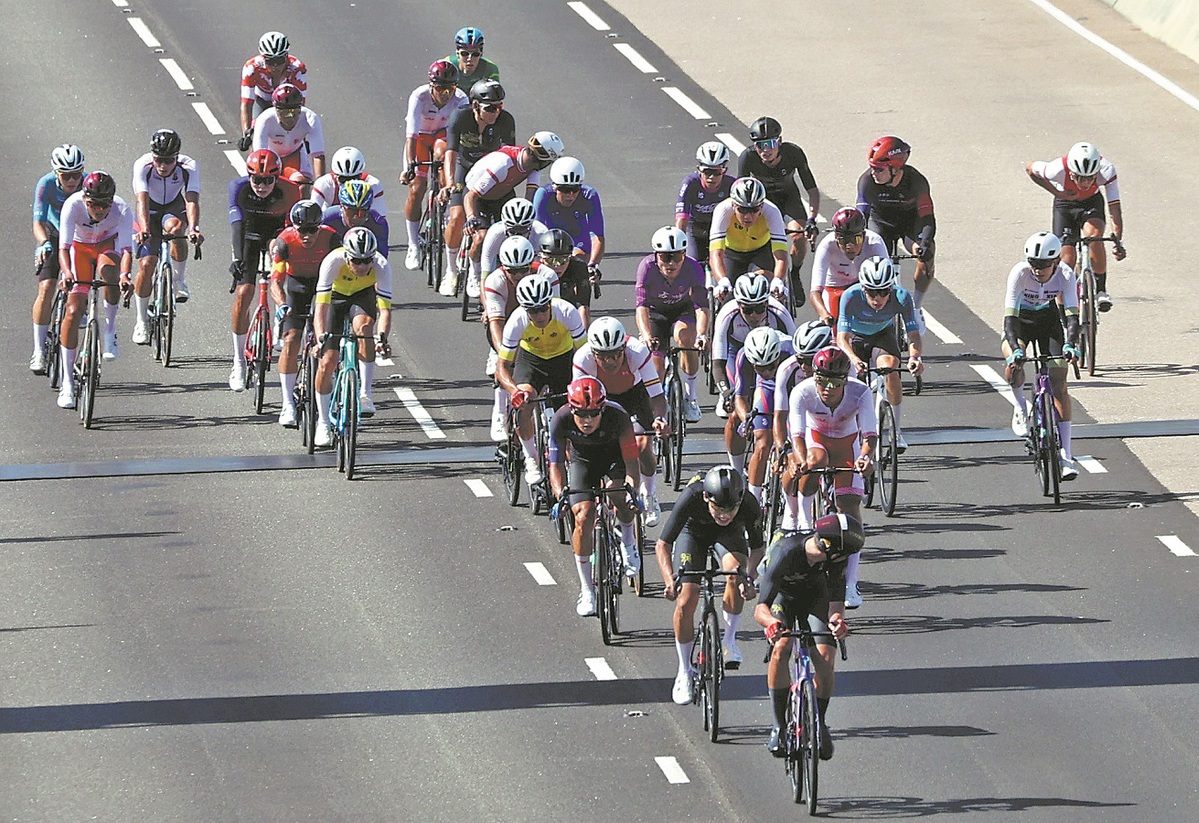
Crowds of people eagerly lined the railings on both sides of the scenic Qinglyu Road in Zhuhai, Guangdong province, on Saturday, as a sea breeze took the edge off the hot day. The spectators were waiting for over 100 competitors in the men's individual road cycling race at the ongoing 15th National Games.
Starting in Zhuhai, then passing through Macao's Taipa Island and Hong Kong's Lantau Island before returning to Zhuhai, the 231.8-kilometer race was a first for the games.
All three games hosts — Guangdong and the Hong Kong and Macao special administrative regions — were linked by a single competition, with riders passing through checkpoints six times without stopping. In the National Games' 66-year history, it was the first staging of a cross-boundary race.
This unique experience for both athletes and spectators was made possible by the ongoing integration in the Guangdong-Hong Kong-Macao Greater Bay Area. In recent years, this integration has been further enhanced by infrastructure development, boosting connectivity and mechanisms that make people-to-people exchanges more convenient.
Macao rider Kam Chin Pok said the event had deepened his understanding of connectivity within the Greater Bay Area.
"It's not just about this competition. Crossing the boundaries is becoming more and more convenient for the public. After the games, I believe people will know more about the Greater Bay Area and how integrated it has become," he said.

Kam, who competed in a trial race in November last year, said the experience of riding across the Hong Kong-Zhuhai-Macao Bridge — which opened in October 2018 — for a second time was still a great thrill.
"The Hong Kong-Zhuhai-Macao Bridge is truly magnificent. Most of the time, we can only travel on it by car. To get this close to the bridge on a bicycle and to feel the wind is a completely different experience, which I think maybe only the National Games could offer," Kam said.
Li Dongyu, who represented Tianjin, echoed Kam's view. He said riding on the bridge was an awe-inspiring experience as the scenery constantly changed, from cityscapes to sea views and tunnels.
"If not for this race, I might never have had the chance to travel between Zhuhai, Hong Kong and Macao, all in just over five hours," said Li, whose role was to collect water and other supplies from the support vehicle for his teammates.
Han Feng, deputy secretary-general of the Chinese Cycling Association, said racing on the bridge — which spans 55 km and is among the world's longest cross-sea bridges — was a bold and challenging concept.
The bridge stands approximately 50 meters above the sea, equivalent to the height of a 20-story building. As cyclists travel at speeds exceeding 40 km per hour amid the vast expanse of sea and sky, the strong sea winds hitting the peloton make maintaining a steady course no easy feat.
"Globally, no cycling race has ever covered 60.8 km on a cross-sea bridge. Despite the difficulty, this will undoubtedly become the highlight of the route," said Han.
Li from Tianjin also praised the efficient organization of the event. "At the crossing checkpoints, staff were waving flags to guide us at each crossing, and there were barriers along the road to prevent crashes. I could feel the support from the event staff in all positions, working to ensure we finished the race safely."

Game of tag
The smooth running of the race involved close cross-boundary coordination and technological innovation.
Min Yuntong, executive deputy director of the Zhuhai executive committee for the National Games, said the most challenging part was to ensure the accuracy and completeness of data. All support vehicles and equipment underwent clearance before the race, Min said.
Radio Frequency Identification readers, connected to the BeiDou Navigation Satellite System, were installed at checkpoints to instantly record athletes' wristband signals via RFID tags. With riders passing through at speeds exceeding 40 km/h, the system guaranteed an uninterrupted race.
Min said the rapid transmission and processing of data meant there were no race delays. "It can handle nearly 200 people passing simultaneously with an upload delay of less than 100 milliseconds. It has ensured the cyclists can pass the checkpoints with zero delay, zero contact and zero waiting time."
The idea of using the radio-frequency identification technology during the race was inspired by clearing private vehicles from Hong Kong and Macao fitted with RFID tags traveling to Guangdong via the Hong Kong-Zhuhai-Macao Bridge. The method ensures the uniqueness and security of access credentials.
Hong Kong team representative Tommy Wu Chun-yin was impressed with the method used for the race. Having registered the athletes' personal information before the race, teams were issued with exclusive wristbands and helmets fitted with multiple RFID tags. Following identity verification through facial recognition and fingerprint checks, participants entered a closed-loop management system for the event.
"Having the tags placed in various locations meant if one scanner missed a tag, another would pick it up, which I found very important. The wristband is also comfortable and doesn't feel restrictive at all," Wu said.
On Saturday, 103 athletes, along with their bicycles, completed inspection and clearance procedures and put on their wristbands. With the inclusion of support staff, a total of 257 people and 68 support vehicles smoothly went through the process.

Close quarters
At around 10:20 am, the race convoy entered the Hong Kong section of the event. The cyclists then tackled a 55.8-km segment that took them through the Hong Kong Port Artificial Island, the North Lantau Highway, and Penny's Bay Highway. The course offered a unique backdrop as it wound past Hong Kong Disneyland Resort, where athletes made a U-turn before heading back to Zhuhai.
To give the public a front-row seat to the historic occasion, a dedicated viewing area was set up along Fantasy Road near the U-turn. Riders sped past the venue at approximately 11:15 am, greeted by spectators' cheers and applause.
Among them were groups of students, including Form Four student Chloe Yeung, who witnessed a large-scale sporting event up close for the first time.
"It was so exhilarating to see the racers speed past right in front of me," Yeung said. "I knew this was a historic event — the first cross-border race linking Guangdong, Hong Kong, and Macao via the Hong Kong-Zhuhai-Macao Bridge. Seeing so many Hong Kong athletes participating was incredibly thrilling."
She said that such large-scale sports events are rare in Hong Kong.
"Realizing I was witnessing this inaugural cross-boundary event and that I could be here to personally encourage the athletes made me excited," she added. "The atmosphere was fantastic. I hope our school organizes more trips to events like this in the future — I would definitely join."

A teacher surnamed Cheng said that as the riders raced past, it allowed spectators to truly experience the intensity and speed of the event. He said it also helped him appreciate the extensive behind-the-scenes planning that made the race possible.
"Seeing everything, from the cyclists to the full complement of support vehicles, demonstrated a thoroughly well-organized and complete event," he said, adding his school will also take students to watch the rugby sevens event.
Form Five student Yu Xin-shun said that the joint hosting of the games provides an important opportunity to foster greater integration and development within the Greater Bay Area. It also facilitated valuable exchanges among young people.
"For example, having Hong Kong athletes participate in this competition creates meaningful opportunities for exchange," Yu explained. "We can learn from the Chinese mainland's advanced training methods and well-established sports systems, which are widely recognized for their excellence."
The race also attracted enthusiastic spectators on the other side of the border. In Zhuhai, parents brought their children to watch the race, and experience the spirit of the National Games on their doorstep.
Many Hong Kong residents made a special trip north to watch the start of the race. "I specifically came to Zhuhai and stayed overnight just to watch the race, even though it was over in a flash," said a resident surnamed Cheng. "With travel to the mainland being so convenient now, it's also good for a short trip."

Podium places
After over five hours of intense riding, a group of riders surged into view near the finish line in Zhuhai — their colorful jerseys drenched in sweat, pushing speeds of over 40 km/h.
At the front of the pack, several sprinters battled fiercely, teeth gritted, charging toward the finish line near the Zhuhai Museum.
After a nail-biting final sprint, Liu Zhicheng, who represented Shandong province, crossed the finish line first with a time of five hours, 17 minutes, and five seconds. He was followed by Beijing's Xue Chaohua and Yunnan province's Hu Haijie, with the podium places decided by mere centimeters.
Liu highlighted the unique challenge of the cross-boundary race. "The second half was run at a relentless pace, with no one holding back," Liu said at the post-race press conference. "It all came down to an extremely intense final sprint for position."
Liu said his team had prepared strategies to handle the crosswinds on the Hong Kong-Zhuhai-Macao Bridge.
"But during the race, the crosswinds on the bridge weren't actually very strong. The main challenge was the headwind on the way out and the tailwind on the way back," Liu said, adding that support for the event was well-rounded.
"From technology to operations, the whole mechanism of the race has been tested and proven. The pioneering model paves the way for greater integration of sports, culture and tourism across the Greater Bay Area," Min, executive deputy director of the Zhuhai executive committee for the National Games, said.
Eric Chan Kwok-ki, chief secretary for administration of the Hong Kong Special Administrative Region government, said at a news conference on Saturday that the event featured seamless real-time boundary crossings, with well-coordinated services and transportation at each checkpoint, fully showcasing the close cooperation among the governments of the Greater Bay Area.
Another cross-boundary event of the National Games, the marathon, will see athletes run across the Shenzhen Bay Bridge, connecting Shenzhen and Hong Kong, on Nov 15.
The 15th National Games is ongoing in Guangdong, Hong Kong and Macao. Chinese Olympic champion and former Chinese women's volleyball team captain Hui Ruoqi has sent her blessings, hoping that the spirit of sports will inspire everyone and spread joy and positive energy.
The ongoing 15th National Games mark the first time the Hong Kong and Macao SARs are serving as co-hosts of a national-level sports event. What does this mean for the future development of the Guangdong-Hong Kong-Macao Greater Bay Area? Watch the video to find out!
The opening ceremony of China's 15th National Games was held in Guangzhou, Guangdong province on Sunday. What was it like at the ceremony? Click the video to hear what the audience had to say!

While audiences across the country were left electrified by the spectacular opening ceremony of the 15th National Games, the Guangdong Olympic Sports Center itself was being energized by 800 photovoltaic panels that will provide continuous green energy throughout the massive multisport gala.
Located in the Tianhe district of the provincial capital Guangzhou, the sports center, which was built in 2001, is one of a number of venues across Guangdong that have been renovated with a green and smart approach in preparation for the ongoing Games.
"Installation of the photovoltaic panels aims to upgrade the venue into a green and low-carbon modern sports facility," said Luo Jianhe, chief designer responsible for the upgrade and renovation of the stadium.
The panels are expected to generate an annual output of over 420,000 kWh, helping to reduce carbon emissions by up to 200 tons, according to Luo.
The Games will take place at a total of 105 sports venues across 18 cities throughout Guangdong and the two special administrative regions of Hong Kong and Macao.

In Guangdong, over 90 percent of the competition venues are existing facilities that have been renovated and upgraded, according to the Games' organizers.
During the renovation, a total of 150,000 square meters of green space, 19 outdoor sports areas and 10 outdoor fitness tracks have been installed in Guangzhou, according to the Games' organizers.
An additional 28,000 sq m of public space and an all-weather circular track on the second-level platform of Guangdong Olympic Sports Center have also been completed.
In Tianhe Sports Center in downtown Guangzhou, a 941-meter professional fitness track around its perimeter and a 700m covered track on the center's second-level platform have been completed, and is expected to serve over ten million runners annually.
All 30 venues in Guangzhou will be powered entirely by green energy, with construction of 13,000 sq m of photovoltaic facilities, according to Guangzhou Eco-environment Bureau.
In terms of green and low-carbon initiatives, the Tianhe Sports Center has become the first large-scale near-zero carbon stadium in the country following its upgrade, achieving a breakthrough carbon reduction rate of over 52 percent, according to the bureau.
In Shenzhen, local authorities have also promoted a self-circulating clean energy ecosystem during the renovation of its existing venues.
The widespread use of high-efficiency direct current inverter air conditioning, all-LED lighting systems and recyclable building materials in Shenzhen have promoted the concept of zero waste sports events.
Additionally, 150 new energy logistics delivery vehicles and four zero-emission, pollution-free hydrogen energy vehicles will be introduced across the venues during the Games. The world's first hydrogen energy emergency power vehicle, integrated with solid-state hydrogen storage technology, will also be put into use in Guangzhou.
In another development, advanced technologies and facilities have helped equip the Games' venues with intelligent operating systems, according to the event's organizers.
At Shenzhen Sports Center, a digital system has been installed, allowing management an intelligent one-screen overview of the venue, and one-click scheduling of resources.
In Guangzhou, introduction of AR real-time navigation at the Guangzhou Gymnasium makes finding seats easy and convenient for spectators, while the AI security system has advanced capabilities to anticipate risks and automatically manage crowd flow.
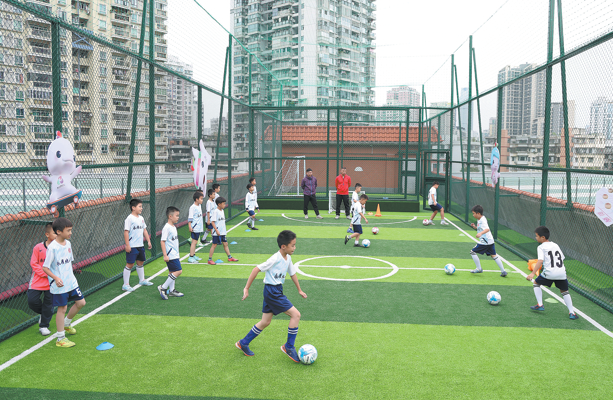
Building on a transformative shift that began at the 13th National Games in Tianjin in 2017 — when mass-participation events were first introduced — the ongoing 15th National Games, being hosted in the Guangdong-Hong Kong-Macao Greater Bay Area, have evolved from an elite-only arena into a truly national sports festival.
This year's edition deepens that legacy. The country's largest-ever premier multisport event to date, it integrates 34 elite competitions with 23 mass-participation events that drew a million grassroots competitors, powerfully translating the slogan of "fitness for all "into widespread action.
The public program features 19 competitive mass-participation sports, such as dragon boating, Go, Chinese chess, Chinese wrestling, shuttlecock, table tennis, badminton, tennis, soccer, basketball and orienteering, along with four demonstration sports: qigong, tai chi, dragon and lion dancing and broadcast gymnastics.
This diverse range of activities enables individuals of all ages and backgrounds to find a sport that suits them. Notably, the majority of these mass-participation events were concluded before the Games' opening ceremony on Sunday.

Cheung Yiu-chiu, 81, who represented Hong Kong in the mass table tennis event at Tianhe Sports Center in Guangzhou back in August, is the oldest competitor at this edition of the Games.
He only began playing table tennis at the age of 66, practicing on the table in his residential community after he retired. He went on to specialize in the chop shot and later won multiple amateur tournaments.
Reflecting on his Games experience, he said: "It felt like competing in the Olympics. The atmosphere was electric. Even the athlete entrance ceremony was just like what we see in major tournaments on TV."
"Although our skill level may not be top tier, we still gave our all to bring honor to Hong Kong," he added.
"The fact that the country places such emphasis on national fitness, even offering a competition slot to someone my age, has been a tremendous encouragement to me," said Cheung.
Burenjirgal claimed the men's 65kg gold medal in Chinese wrestling. Hailing from the Xilin Gol Grasslands in North China's Inner Mongolia autonomous region, he manages a herd of 200 sheep, 50 cattle and 50 horses.
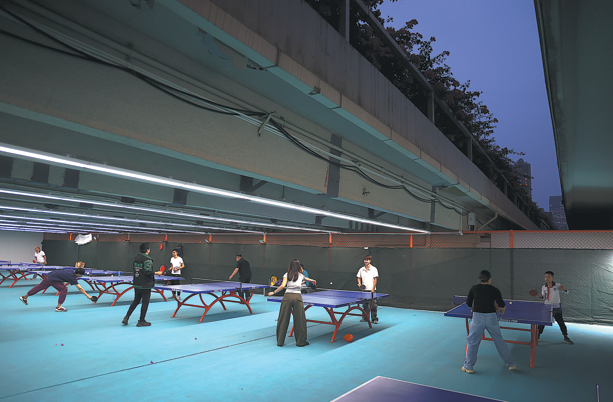
As a boy, he would grapple with his friends by the Xilin River, and the loser's penalty was to catch a fish — often coming up empty-handed, but filled with laughter. For Mongolians like him, wrestling is more than just a sport, it's a symbol of their ethnic culture. It embodies the Mongolian spirit of bravery, unity and reverence for tradition.
In anticipation of the Games, Burenjirgal started his preparation four months in advance, focusing on weight loss and honing fundamental skills such as footwork, takedowns, defense and counterattacks.
His efforts were rewarded on July 24 in Qingyuan, where he competed in the final and emerged champion. The trip also offered him, quite literally, his first taste of Guangdong province, where he finally sampled the local delicacies he had long wanted to try, including double-layer milk pudding and char siu — flavors he found strikingly different from the grassland cuisine of his hometown.
He plans to return to the Greater Bay Area during the official competition period to further immerse himself in the region's cultural and culinary offerings.
One of the Games' most anticipated events, the men's individual cycling road race, concluded on Saturday. The riders covered a 231.8-kilometer course, crossing the customs points six times without interruption — making it the first cross-boundary race in the Games' history and the only event linking all three host regions in a single competition.
"We could feel the enthusiasm of local residents who cheered for us along the route," said bronze medalist Hu Haijie from Yunnan province. "Cycling across the bridge was breathtaking. It was a pleasure to take in the scenery along such a well-equipped course with beautiful views."
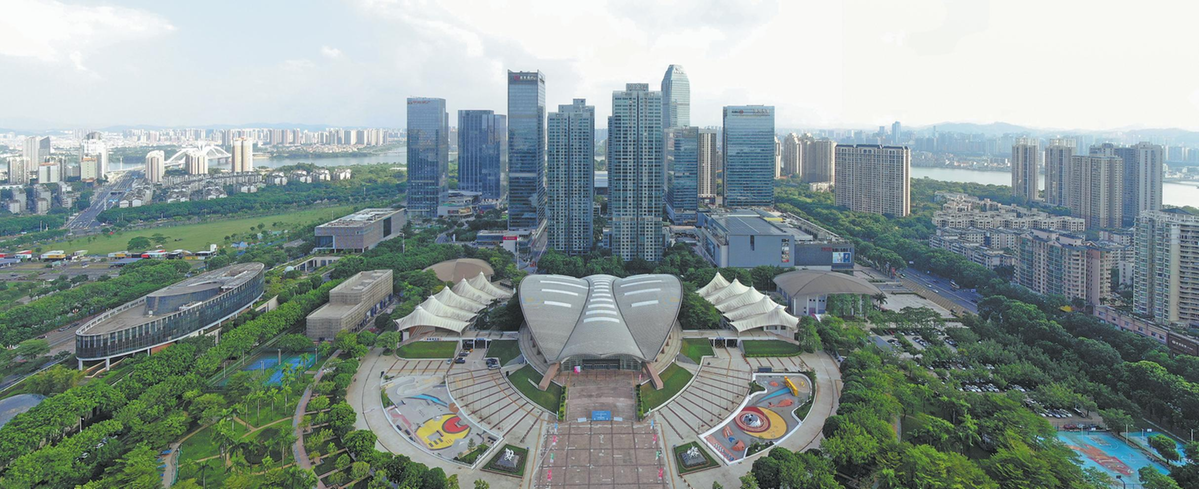
For the National Games, a total of 105 venues across 18 cities in the Greater Bay Area were put into service. This regional co-hosting model has not only deepened cooperation among Guangdong province and special administrative regions of Hong Kong and Macao in infrastructure connectivity, regulatory alignment and resource sharing, but has also strengthened people-to-people bonds and cultural exchanges.
A notable example is the GBA dragon boat team — the first combined squad formed through regional collaboration — which secured sixth place in the mass dragon boat competition held in Foshan, Guangdong.
"It's a special honor to represent the GBA team," said Zong Zeonjyun, dragon boat athlete from Macao. "I never imagined I would have the chance to train and compete alongside teammates from Guangdong and Hong Kong. Today, we're not just teammates, we feel like family."
Volunteers also personify this synergy. Sun Mengyue, a student from the Macao University of Science and Technology serving as a volunteer for the Games, shared that the training program had enabled her to learn more about Macao's history, while equipping herself with practical emergency response skills.
"One of my classmates is volunteering at the Shenzhen competition zone. It feels incredible to be contributing to the Games in different locations together," Sun told People's Daily. "We're all looking forward to the official competition period."
She added that she feels honored to participate and feels part of Macao's active role in building the GBA, which contributes to the country's development.
Labubu, one of the biggest global collectible toy phenomena of the past few years, has been crowned as China's most recognizable and influential pop culture intellectual properties in the eyes of the world, according to a newly released report.
The furry forest monster beat out blockbuster movie Dead To Rights, which came in a close second, said the report released by Beijing-based think tank the Academy of Contemporary China and World Studies at the World Internet Conference Wuzhen Summit in Wuzhen, Zhejiang province, on Saturday.
The report offers a data-driven assessment of how Chinese cultural IPs and local cultural symbols spread overseas over the past year.
According to its assessment, Labubu, sold by Beijing-based toy maker Pop Mart, led the top 10 Chinese online pop-culture IPs. The blockbuster film Dead To Rights placed second, and Ne Zha 2 ranked third.
Other entries in the top 10 include the breakout film Nobody, ranking seventh, and the Chinese game Where Winds Meet, ranking ninth.
Dead To Rights is set against the backdrop of the 1937 Nanjing Massacre during the Chinese People's War of Resistance Against Japanese Aggression (1931-45), telling the story of a group of civilians who took refuge in a photo studio amid the wartime chaos and risked their lives to expose atrocities committed by the invading Japanese army.
Ne Zha 2 reimagines the classic myth, telling the story of the Chinese mythological character Ne Zha and his family and friends as they overcome hardship and stand up to hostile powers.
Commenting on the findings, Li Yafang, head of the academy, said the globally resonant Chinese IPs "no longer aim to preach, but use high-quality products and compelling stories" to make the world actively understand China.
The report tracked the performance of Chinese cultural symbols across more than 4,000 mainstream media outlets worldwide, multiple international social media platforms and search engines, as well as how they are referenced by leading artificial intelligence models such as DeepSeek and ChatGPT, based on data from November 2024 to September 2025, the think tank said.
Li Wei, deputy dean of Peking University's School of New Media, said the toy Labubu "hit a psychological sweet spot for young people by awakening a childlike joy".
Labubu's design is "cute, odd yet healing", and the blind-box buying experience adds a jolt of excitement, she added.
Chen Gang, deputy dean of the School of Art and Communication at Beijing Normal University, said the reason these Chinese IPs have drawn global attention is that they sparked emotional resonance strong enough to transcend nationality, ethnicity and cultural differences.
For example, Ne Zha 2 is, at heart, a universal, empathetic story, he said. The film reframes Ne Zha as an ordinary person standing up to his destiny, with a narrative rooted in Chinese mythology, Chen said.
Such storytelling, he said, carries universally recognizable values shared with people around the world. "This kind of emotional resonance is more likely to draw worldwide attention because it crosses national borders and cultural differences."
Chen added that two other breakout films this year, Dead To Rights and Nobody, follow the same pattern: ordinary people making choices amid big historical moments.
"They're different from grand, macroscopic perspectives," he said, suggesting that a human-scale perspective is what really travels.
In addition, based on data analysis, the report also identified five local-culture hot spots with international influence in the past 11 months.
The top three were the World Games held in Chengdu; the "cyber city" image that blends tradition and modernity in Chongqing; and the Shanghai Cooperation Organization Summit held in Tianjin.
Li, head of the think tank, said Chongqing has become a top viral travel destination on global social media platforms thanks to its unique urban landscape.
"These authentic, multidimensional local stories have made the image of contemporary China more vivid on the world stage," she said.
jiangchenglong@chinadaily.com.cn
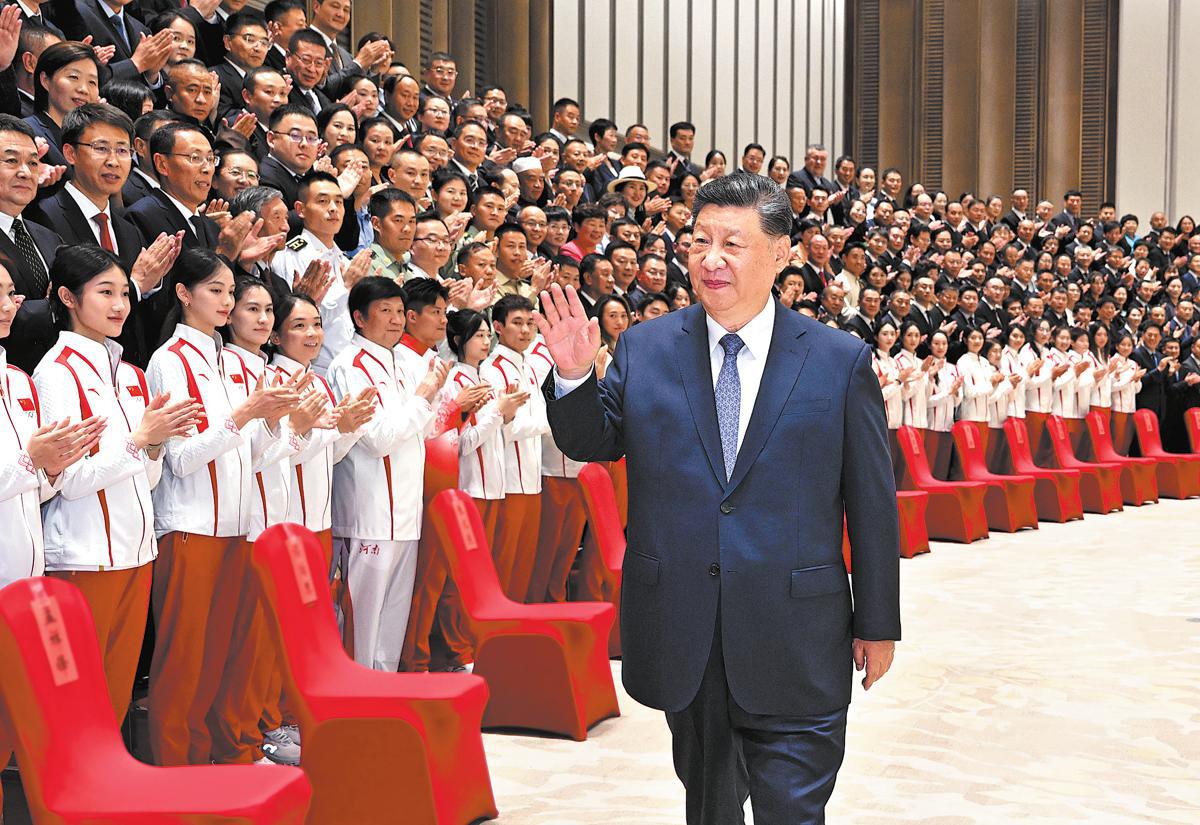
With southern China's culture and cross-regional integration presented in a visual spectacle, a gala ceremony left the entire Guangdong-Hong Kong-Macao Greater Bay Area stoked on Sunday as President Xi Jinping declared the 15th National Games open in Guangzhou, the capital of Guangdong province.
Launched in 1959 to promote mass sports participation, China's National Games have opened a new chapter with the groundbreaking 2025 edition, being jointly held for the first time in Guangdong province and the Hong Kong and Macao special administrative regions. The 15th National Games kicked off with great fanfare, celebrating their influence in pulling the Greater Bay Area further together, not just in sports exchanges but also in terms of cultural and economic cohesion.
After overseeing the parade of athletes and a series of ceremonial rituals, Xi announced the opening of the domestic sporting gala — held once every four years with a competition program similar to that of the Olympics — to rousing cheers from the crowd of over 80,000 at Guangdong Olympic Sports Center Stadium.
Before attending the ceremony, Xi met on Sunday afternoon in Guangzhou with individuals and representatives of various sports groups, who were honored as role models of mass fitness and competitive sports promotion.
Kirsty Coventry, the new president of the International Olympic Committee and Thomas Bach, the IOC's honorary president for life, were among guests at the opening ceremony.
As the largest edition of the games, in numbers of participants and host cities, the Greater Bay Area games feature 419 medal events across 34 sports, involving over 14,000 professional athletes on its competitive program. A parallel mass sports program has also engaged more than 1 million amateurs in preliminary rounds of 166 events since February.
As an early highlight of the night, a joint delegation of athletes representing Guangdong, Hong Kong and Macao marched together at the end of the athletes' parade, drawing warm applause from the crowd.
As part of an extensive display of the history and culture of Guangdong, Hong Kong and Macao, the opening ceremony presented traditional activities and art, ranging from dragon boat racing and lion dances to drum and gong performances in an intriguingly immersive fashion, enhanced by modern technology and dazzling audiovisual effects.
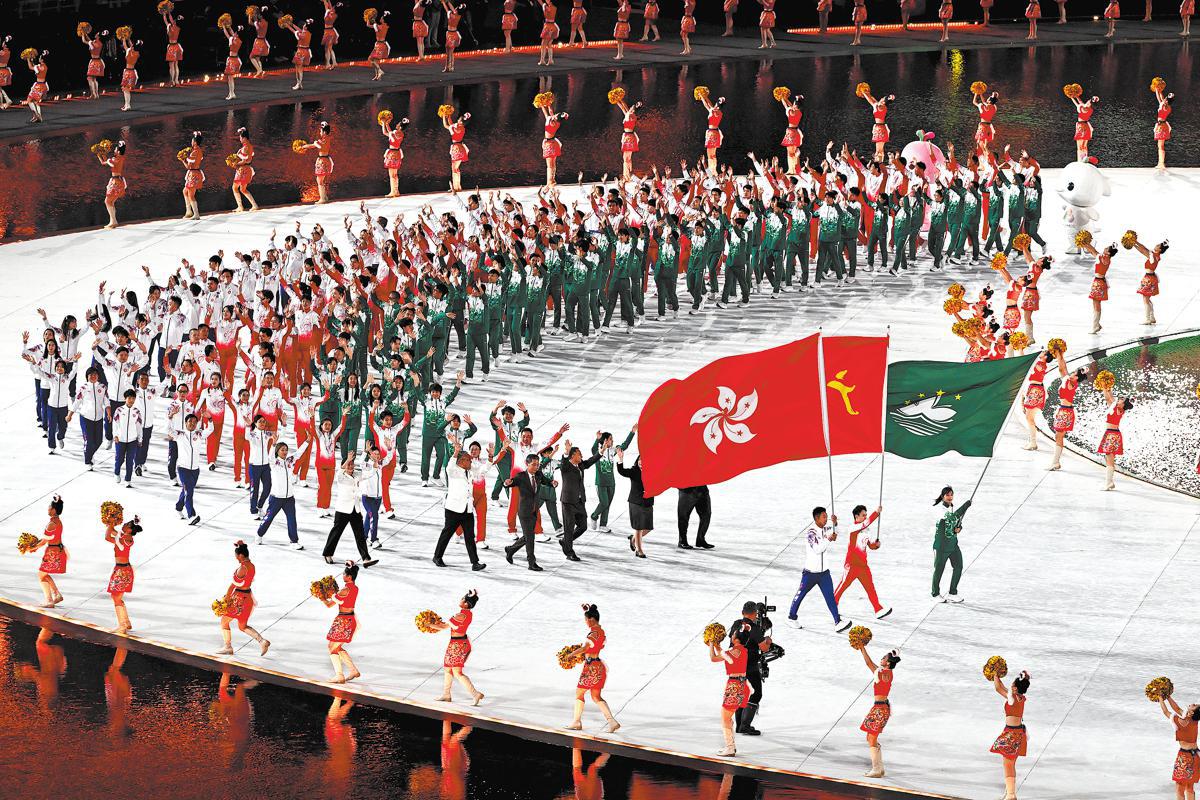
The lion dancers brought the crowd to its feet, taking advantage of virtual reality technology that made the performance even more spectacular, before the racing dragon boats drew "oohs" and "aahs" from spectators who, aided by augmented reality technology, felt as if the boats were being paddled into the crowd.
During the jubilant performances, iconic landmarks, such as Hong Kong's Victoria Harbour, the Ruins of St. Paul's in Macao and the Canton Tower in Guangzhou, took shape as 3D background projections, showcasing unique attractions of the Greater Bay Area's past and present.
Huang Kunming, a member of the Political Bureau of the Communist Party of China Central Committee and Party chief of Guangdong province, delivered a speech in which he extended his warm welcome to all participants.
"The National Games being held together by Guangdong, Hong Kong and Macao will write a new chapter of the integrated development of the Greater Bay Area. We will play a generous host to present a streamlined, safe and splendid sporting extravaganza," he said.
Hong Kong Chief Executive John Lee Ka-chiu and Macao Chief Executive Sam Hou-fai both pledged to build on the games' momentum to further facilitate sports, cultural and economic collaborations across the Greater Bay Area.
"This 15th edition not only represents an innovation of the National Games, but also accelerates Hong Kong's integration into the overall development of the country," Lee said in his speech.
Sam said the games "will help build a brighter future of the GBA as yet another example of the significance of the 'one country, two systems' policy".
As a symbolic milestone of the games, the men's road cycling race charted a 230-kilometer route linking Zhuhai, a co-host city in Guangdong, with Hong Kong and Macao on Saturday, marking the first ever cross-boundary sporting event held in the Greater Bay Area.
For the exciting finale, three renowned athletes — Hong Kong's Olympic champion fencer Cheung Ka-long, Guangdong's star sprinter Su Bingtian and Macao martial artist Li Yi — completed the final leg of the torch relay before together igniting a flame ring as the games' main cauldron.
Lu Wanqing and Wang Jing contributed to this story.
sunxiaochen@chinadaily.com.cn
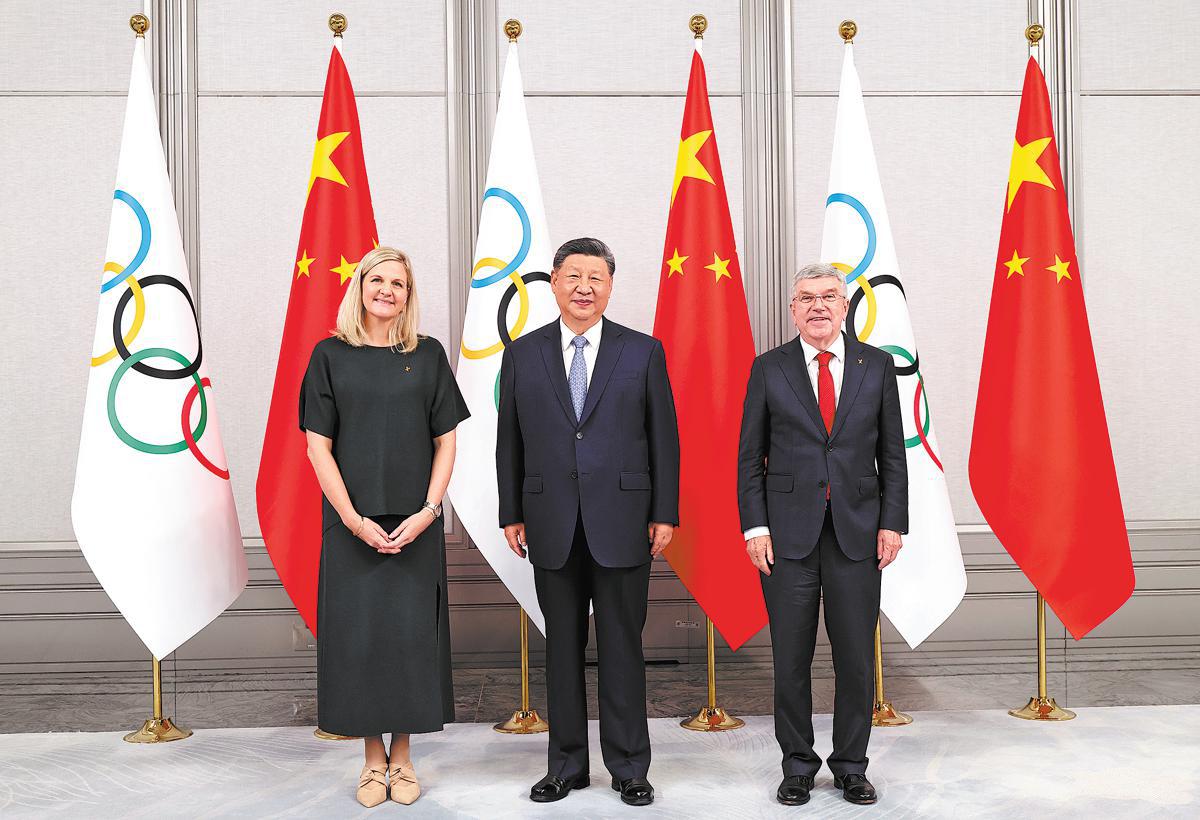
President Xi Jinping expressed on Sunday China's readiness to provide more wisdom and strength to global sports governance and make greater contributions to building a community with a shared future for humanity.
Xi made the remarks when meeting with International Olympic Committee President Kirsty Coventry and Honorary President for Life of the IOC Thomas Bach in Guangzhou, Guangdong province, ahead of the opening ceremony of China's 15th National Games.
Xi said that the Olympic spirit, which represents an important part of human civilization and embodies people's shared aspiration for a better world, aligns closely with China's vision of building a community with a shared future for humanity.
China has always firmly practiced, safeguarded and promoted the Olympic spirit, he said, noting that in recent years, China and the IOC have supported each other in advancing sports development and have jointly accomplished many remarkable undertakings.
Recalling the 9th Asian Winter Games held earlier this year in the icy and snowy city of Harbin, the capital of Heilongjiang province, Xi said the meeting in the spring-like city of Guangzhou reflects the close and friendly ties between China and the IOC.
China stands ready to deepen high-level cooperation with the IOC and advance the nation's goal of becoming a leading country in sports as well as in the global Olympic movement.
As the highest-level and largest comprehensive sports event in China, the 15th National Games mark the first time the National Games are being jointly hosted by Guangdong, Hong Kong and Macao.
Xi said the Guangdong-Hong Kong-Macao Greater Bay Area, which comprises nine cities in Guangdong's Pearl River Delta region as well as the Hong Kong and Macao special administrative regions, is one of the most open and economically vibrant regions in China.
Promoting its development aims to turn the area into a strategic underpinning for China's new development paradigm, a demonstration area for high-quality development, and a pacesetter of Chinese modernization, he noted.
It is believed that the 15th National Games will not only showcase new achievements in China's sports development in the new era, but also present the vibrant vitality of Chinese modernization in the Guangdong-Hong Kong-Macao Greater Bay Area, Xi said.
The IOC guests said they were deeply impressed by the vitality and remarkable progress of China's modernization, as seen in the development of the Guangdong-Hong Kong-Macao Greater Bay Area.
They highly commended China's active efforts in promoting the Olympic spirit and its significant contributions to the global Olympic movement.
The IOC appreciates China's long-standing support and looks forward to further deepening cooperation with the country to advance the Olympic cause worldwide, foster unity among people of different countries, and promote world peace, they said.


